




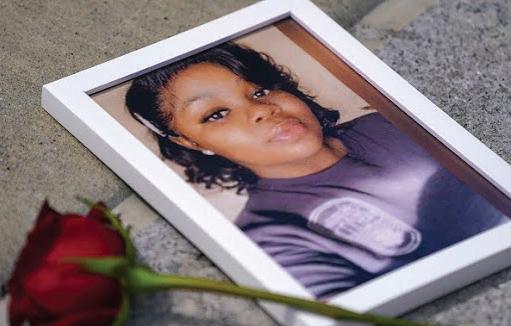
By Joseph Williams
n 2024, when a federal jury convicted a former Louisville cop for his role in the botched raid that killed Breonna Taylor, he faced life behind bars. But last week, the Department of Justice — under new leadership handpicked by President Donald Trump — argued that the defendant is carrying a heavy “emotional burden” and shouldn’t serve more than a day.
On Monday, a federal judge said no.
In a sharp rebuke of the revamped DOJ, Judge Rebecca Grady Jennings ruled that Brett Hankinson — the only officer involved in the raid to answer for Taylor’s death, even though he didn’t shoot her — should spend almost three years in a federal prison.
Saying she was “troubled” by the department’s argument for leniency, Jennings imposed the sentence against Hankinson, 49, during an afternoon hearing in Louisville U.S. District Court. Jennings said the one-day sentence prosecutors wanted “is not appropriate,” it minimizes the jury’s verdict, and that it was startling Hankison’s reckless actions didn’t harm more people.
“Never in my career as a lawyer have I heard the prosecutor argue so adamantly for a convicted felon who had been convicted by a jury who heard all the evidence.”
Federal sentencing guidelines recommended Hankison serve between 10 and 14 years for violating Taylor’s civil rights. The former officer, who was fired from the Louisville Police Department, apologized to Taylor’s fam-
ily before the sentence was imposed; he’ll remain free on bond until the Bureau of Prisons assigns him to a facility.
Outrage at the Justice Department
Speaking after the hearing, civil rights attorney Ben Crump, who represents Taylor’s family and helped them win a $12 million wrongfuldeath judgment against the city, said he was outraged by the Justice Department’s suggestion that Hankison should not be punished — and praised the judge for ignoring it.
Seeing both the prosecutors and the defense lawyers argue for leniency made the five-hour hearing seem like “a George Orwell story,” Crump said.
“There was no prosecution in [the courtroom] for us. There was no prosecution in there for Breonna,” said Tamika Palmer, Breonna Taylor’s mother.
“Never in my career as a lawyer have I heard the prosecutor argue so adamantly for a convicted felon who had been
■ See BREONNA on page 5
By Riley Bruce Contributing Writer
he fifth annual Minne-
apolis Black Business Week kicked off Thursday with a powerful celebration at the historic intersection of 38th Street and Chicago Avenue in South Minneapolis. The corner, internationally known as the site of George Floyd’s murder in 2020, is now the backdrop of a renewed Black business renaissance. Vendors, entrepreneurs, and hundreds of community members gathered to celebrate the legacy, and future, of Black entrepreneurship.
“In the past five years, we’ve seen a bunch of new businesses on the block,” said KingDemetrius Pendleton, owner of Listen2Us Studio. “What many had written off is growing fruit.”
Since 2020, at least five new Black-owned businesses have opened at 38th and Chicago, including Pendleton’s
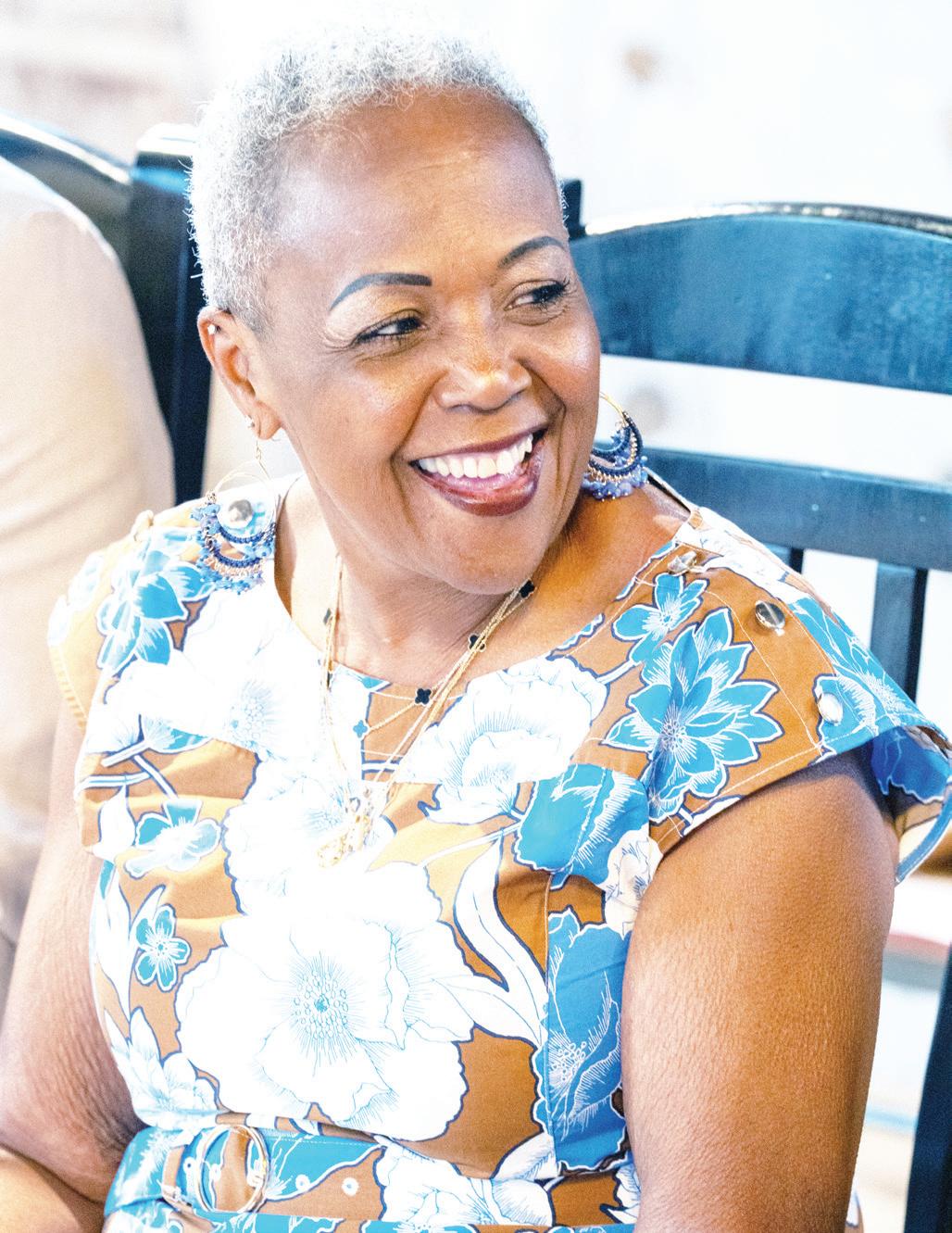
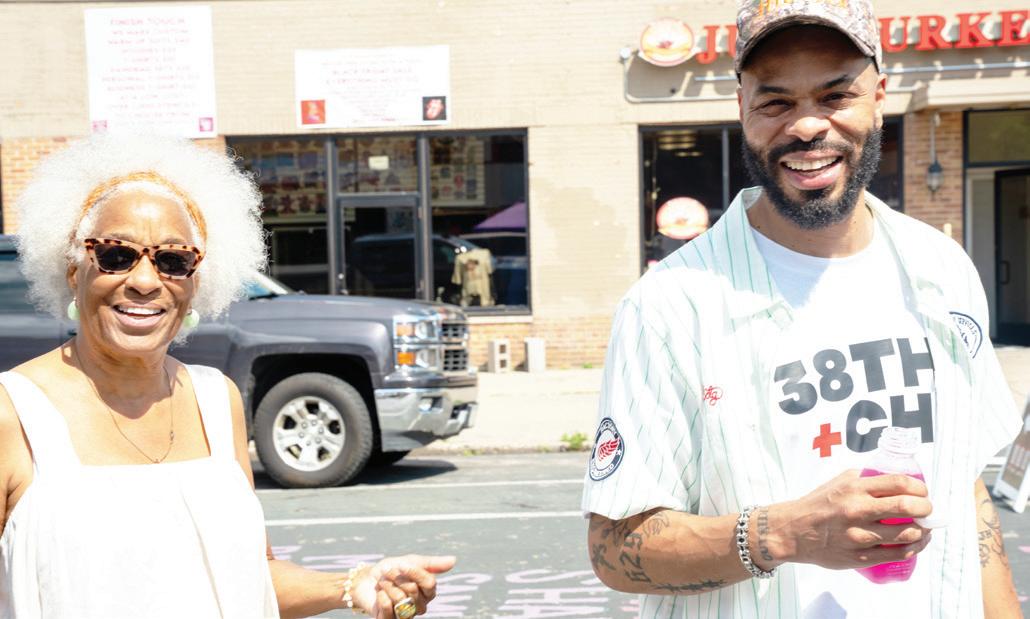
studio, Bichota Coffee, City Food Studio, Mystic Healing Stones, and Plot Gallery. They’ve joined longstanding neighborhood staples like Just Turkey, Smoke in the Pit, and Finish Touch Boutique to create a vibrant commercial corridor once again anchored in Black ownership.
“We’re already brilliant”
C. Terrence Anderson, owner
of Bichota Coffee, addressed the stigma often associated with the location head-on.
“We’re a specialty coffee shop in what some people think is the most difficult place to do business,” said Anderson. “That’s a narrative that isn’t true if you’re on the ground here. I find love, joy, and connection with this community.” According to a 2023 report from the Federal Reserve Bank of Minneapolis, Black
Minnesotans represent about 7% of the state’s population but own only around 1% of its businesses. Nationally, that number is closer to 2.4%. Disparities in access to capital, property ownership, and technical assistance continue to create

By Riley Bruce Contributing Writer
mir Locke Should Be Alive,” read a banner held by community members during a press conference at Minneapolis City Hall on July 22. The gathering, organized by Communities United Against Police Brutality (CUAPB), condemned the Minneapolis Police Department’s decision to appoint Sgt. Mark Hanneman as its new use-of-force training officer.
On Feb. 2, 2022, Hanneman fatally shot 22-year-old Locke during a pre-dawn no-knock raid at Bolero Flats in downtown Minneapolis. Locke, who was not named in the warrant, was awakened on a couch by officers entering with guns drawn. He was shot within seconds of the raid’s start.
man declined to prosecute, and civil litigation by Locke’s family remains pending.
“You appoint the officer, who took my son’s life, to train others?”
“If Officer Mark Hanneman understood how to properly use force in a situation like Amir Locke’s, Amir would still be alive today,” said attorney and activist Nekima Levy Armstrong during the press conference.
A troubling pattern Critics argue Hanneman’s appointment represents a larger pattern of officers with violent records being elevat-
founder of Families Supporting Families Against Police Violence.
Garraway listed other officers who were in training roles when they killed civilians:
• Derek Chauvin, an MPD field training officer, murdered George Floyd in 2020.
• Kim Potter, a Brooklyn Center training officer, killed Daunte Wright in 2021.
• Jason Schmidt, another MPD training officer, fatally shot Dolal Idd in 2020.
“These are not isolated cases,” said Garraway. “We must stop promoting the people who have caused the most harm.”
Andre Locke, Amir Locke’s father, called the promotion “disrespectful.”
“You appoint the officer, who took my son’s life, to train others?” he said. “That is absolutely disrespectful.”
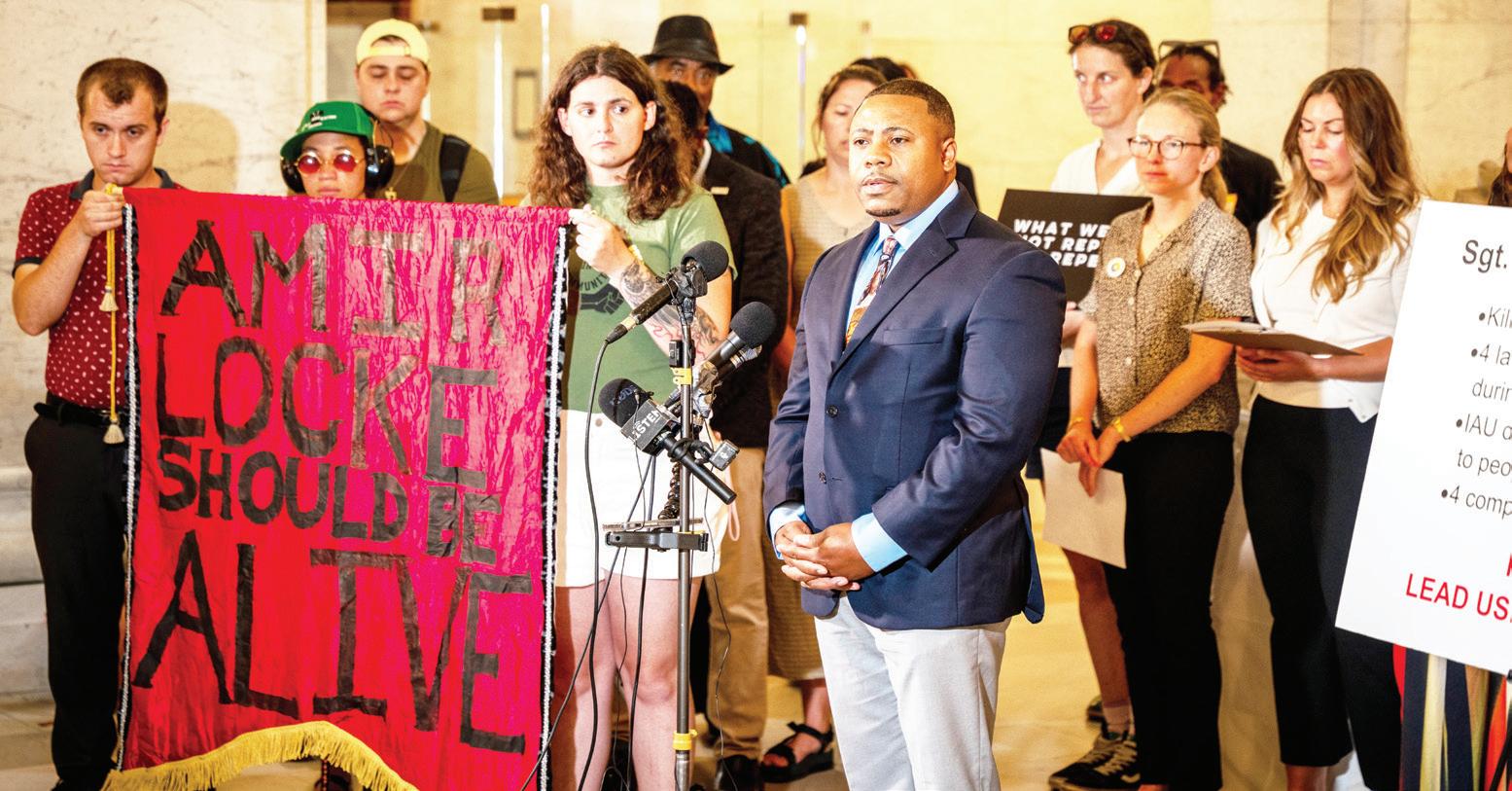
Although Hanneman was not criminally charged, Minnesota Attorney General Keith Ellison and then-Hennepin County Attorney Mike Free-
ed to training roles within law enforcement. “There’s a disturbing history of awarding officers who kill our people,” said Toshira Garraway,

By Binta Kanteh Contributing Writer
The majority of incarcerated women in the U.S. are mothers, often the primary caregivers to young children. Each year, an estimated 58,000 pregnant people are admitted to prisons and jails nationwide, according to the Advocacy and Research on Reproductive Wellness of Incarcerated People (ARRWIP).
hosted 13 doulas from eight states — including Virginia, Washington, Mississippi, and Wisconsin — for an advanced prison doula training in South Minneapolis. Held at the New City Center, the three-day training was designed to expand the doulas’ skills and deepen their impact with incarcerated clients.
Tracey Russell, a full-spectrum doula from Wisconsin and a trainer at the event, re-
many doulas are drawn to this work because they’ve been directly impacted by incarceration or given birth while incarcerated themselves.
“There are so many differences between supporting clients in the community versus in a prison,” Baker said. “They’re not choosing where they deliver, what hospital, or what care provider. They can’t have their loved ones present — the other parent often isn’t
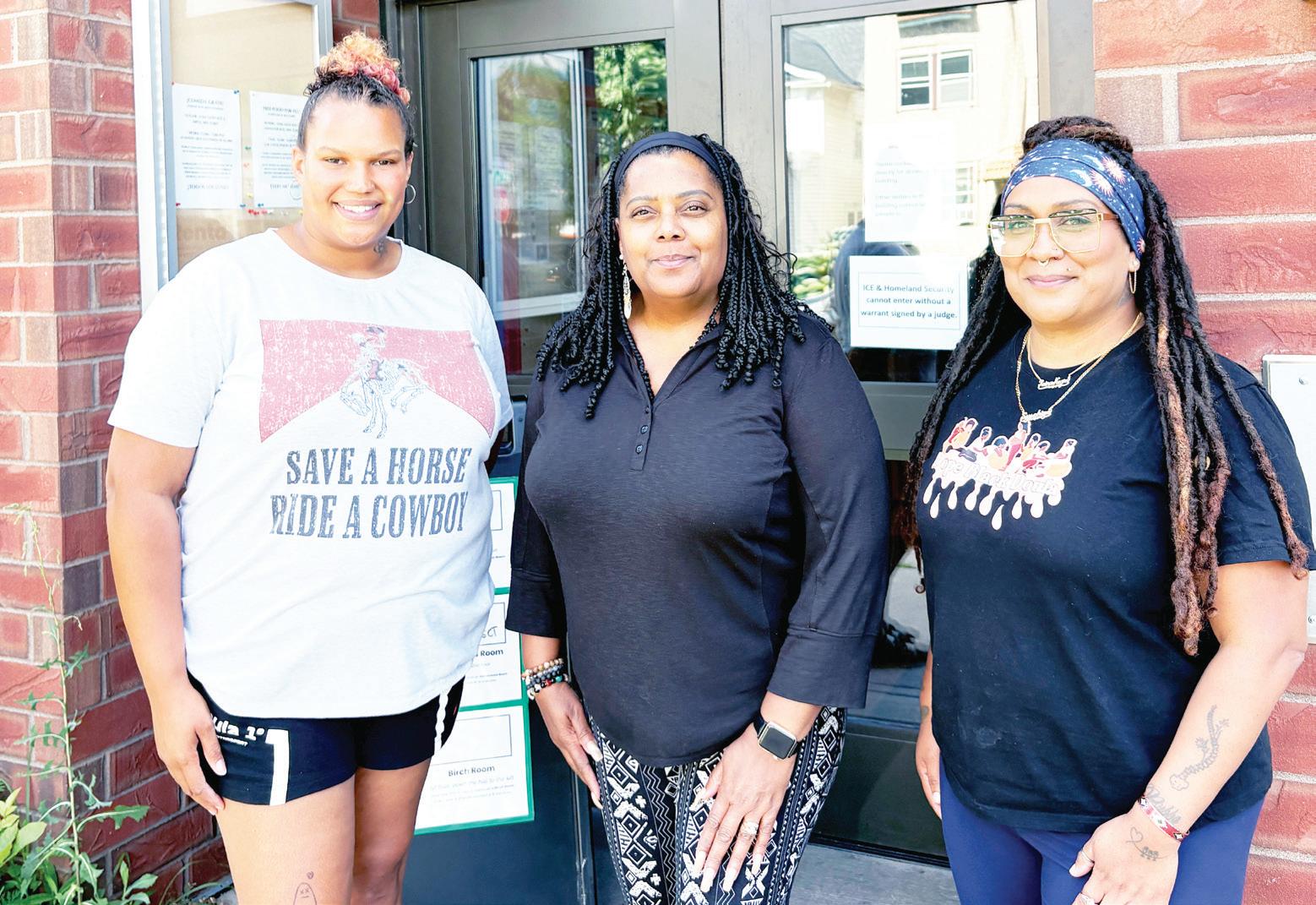
Since 2010, the Minnesota Prison Doula Project (MNPDP) has worked to ensure the safety and well-being of pregnant and postpartum mothers behind bars. Offering emotional, physical, and educational support, MNPDP is part of a national coalition under The Ostara Initiative — a name that symbolizes spring and new beginnings. Ostara includes partner programs in Alabama, Oregon, Illinois, California, Texas, and now Minnesota.
On July 16–18, MNPDP
called what she learned when she first took the training herself.
“It really helped me understand and level-set the expectations and limitations that exist when providing doula services inside a facility,” said Russell. “Today, I hope that the women coming from different states can take what they’ve learned and implement it in their own jails and prisons.”
Raelene Baker, director of Ostara’s Bureau of Prisons Doula Program, explained that
allowed in the room. All of those choices are taken away.”
Abigail Meyer, a South Minneapolis native and reentry doula with MNPDP, said she was proud to have the advanced training hosted in her hometown for the first time. Meyer connects with clients while they’re incarcerated and continues to support them through reentry.
“What I love most is building relationships while people are still inside,” she said. “For a lot of our clients, it’s the only safe space they have to talk about

their families, to talk about breaking generational curses and trauma. I learn from them every week.”
Meyer will expand her services through weekly drop-in hours at the Anything Helps Northside Hub in North Minneapolis, where returning citizens and their families can access baby supplies, peer support, and resources every Wednesday from 12 p.m. to 2 p.m.
One training participant, Syah Russell of Vancouver, Washington, was inspired to become a prison doula after giving birth while incarcerated as a teenager. She now volunteers at Coffee Creek Correctional Facility, a women’s prison in Oregon.
“When I was 16, I was pregnant when police came to my house with a warrant for someone I didn’t know,” she recalled. “They slammed me on the ground, took me to adult jail. I was bleeding and sat there for two days before I saw a doctor.”
Syah was shackled during labor, denied skin-to-skin contact, and not even allowed to name her child.
“I got out and didn’t have a connection with my baby. It took months before I could even hold her,” she said. “That trauma stayed with me through my teens and even now, at 40.”
Healthcare services in correctional facilities vary greatly, and the needs of pregnant people are often unmet or dismissed. MNPDP founder

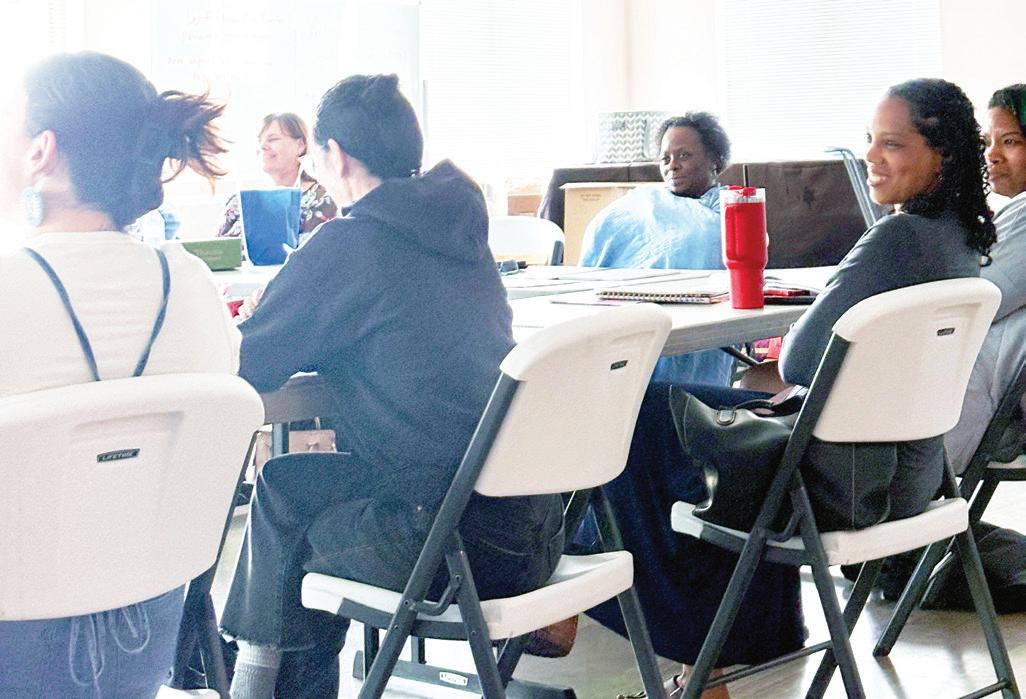
Erica Gerrity believes trained doulas are one vital piece of a broader solution.
“Prisons are where a lot of intersecting health disparities come together — mental health, chronic disease, maternal care, substance use disorder,” said Gerrity. “People are incarcerated because these public health issues weren’t addressed in the community. In the prisons where we don’t have doulas, the conditions are beyond inhumane.”
“There are so many differences between supporting clients in the community versus in a prison.”
MNPDP’s reentry specialist, Tierre Caldwell, agrees. As someone who supports both incarcerated parents and returning citizens, he’s seen firsthand how doulas bring hope and knowledge to families.
“Doulas offer emotional support, physical support, and support in the community,” said Caldwell. “They’ve taught me — especially as a man — about pregnancy, what infants need, what mothers go through in each trimester. A lot of parents never got that. But through doulas, we’re raising up more informed families.”
As the Ostara Initiative continues to grow, doulas trained to serve incarcerated parents are helping shift the narrative — restoring dignity, building connections, and giving families the tools they need for healing and transformation.
Learn more about the Minnesota Prison Doula Project at www.ostara.org.
Bintah Kanteh is a contributing writer for MSR with interest in public policy and local immigrant communities.



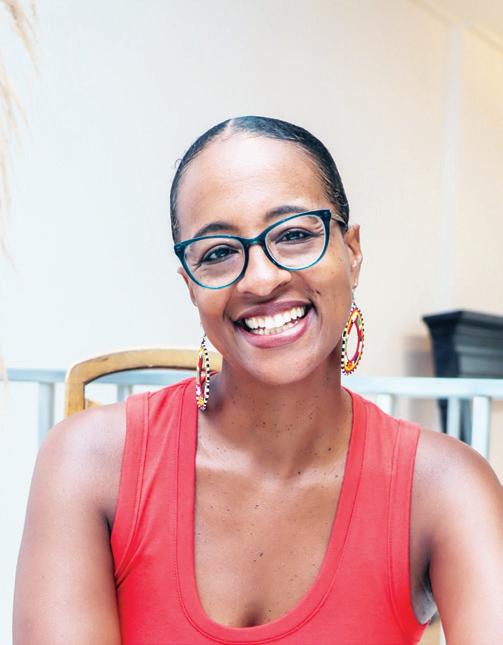
1. Quality: Is it what it says it is?
Supplements are not subject to the same FDA approval process as pharmaceutical drugs. That means products can hit the shelves without being tested for safety, effectiveness or even basic ingredient accuracy.
By Dr. Ayanna Quamina, ND Columnist
Whenever I lead a health workshop or meet someone new, I’m almost always asked the same thing: “I’m dealing with ‘condition X,’ what can I take to help?”
As a naturopathic doctor, supplements, also known as nutraceuticals, are part of my daily toolkit. These include vitamins, herbs, probiotics, and other natural compounds that support the body’s systems. When used appropriately, they can be powerful allies in our health journey. But when misused or poorly chosen, they can also cause harm — or, at best, be a waste of money.
If you’re curious about what makes a supplement effective, safe, and worth taking, here are a few essential things to know:
According to New York Times, in a 2015 investigation, the New York Attorney General found that just 21% of herbal supplements from major retailers actually contained the ingredients listed on the label. The rest included fillers like powdered rice, houseplants or wood pulp.
To this day, there is still no governing body that verifies supplement contents before they’re sold. That’s why choosing high-quality, thirdparty-tested brands and trusted suppliers is crucial.



2. Need: Do you actually need it?
People often start a new supplement because a friend or influencer swears by it. But symptoms like fatigue, bloating or insomnia can have dozens of root causes, and what works for one person might not help (or could harm) another.
Let’s say someone recommends a supplement that helps with circulation. You try it for fatigue without realizing your
symptoms are due to a thyroid issue. Now you’re experiencing side effects that confuse your doctor and complicate your care. Remember: just because something is “natural” doesn’t mean it’s automatically safe for you.
3. Know the interactions Some commonly used herbs and supplements can cause issues depending on your health status or other
medications:
• St. John’s Wort — Popular for mood support, but it interacts with many drugs by using the same liver detox pathways. It can either weaken or dangerously intensify other medications.
• Lemon Balm — A calming herb that affects thyroid function. If you have a thyroid condition or take thyroid meds, it may worsen symptoms.
• Milk Thistle — Often used for liver health, but can also alter how your liver processes other medications.
So before you take a supplement, ask:
• Why am I taking this? What specific need is it addressing?
• What will it do for my body and health history?
• When should I take it, and when shouldn’t I?
• How much is appropriate and safe?
• How long should I take it, and howwill I know it’s working?
Final thought: “Every thing isn’t for everybody.”
Supplements can be incredibly helpful, but only if chosen with care. Work with a trusted practitioner or knowledgeable advisor. Ask questions. Be skeptical of generic online claims.
This isn’t about fear. It’s about empowerment — giving your body the right tools, at the right time, in the right way.
Have questions? Want to connect? You can email Dr. Q at info@drayannaq.com.
“Let’s keep your health journey intentional, informed and just right for you.”


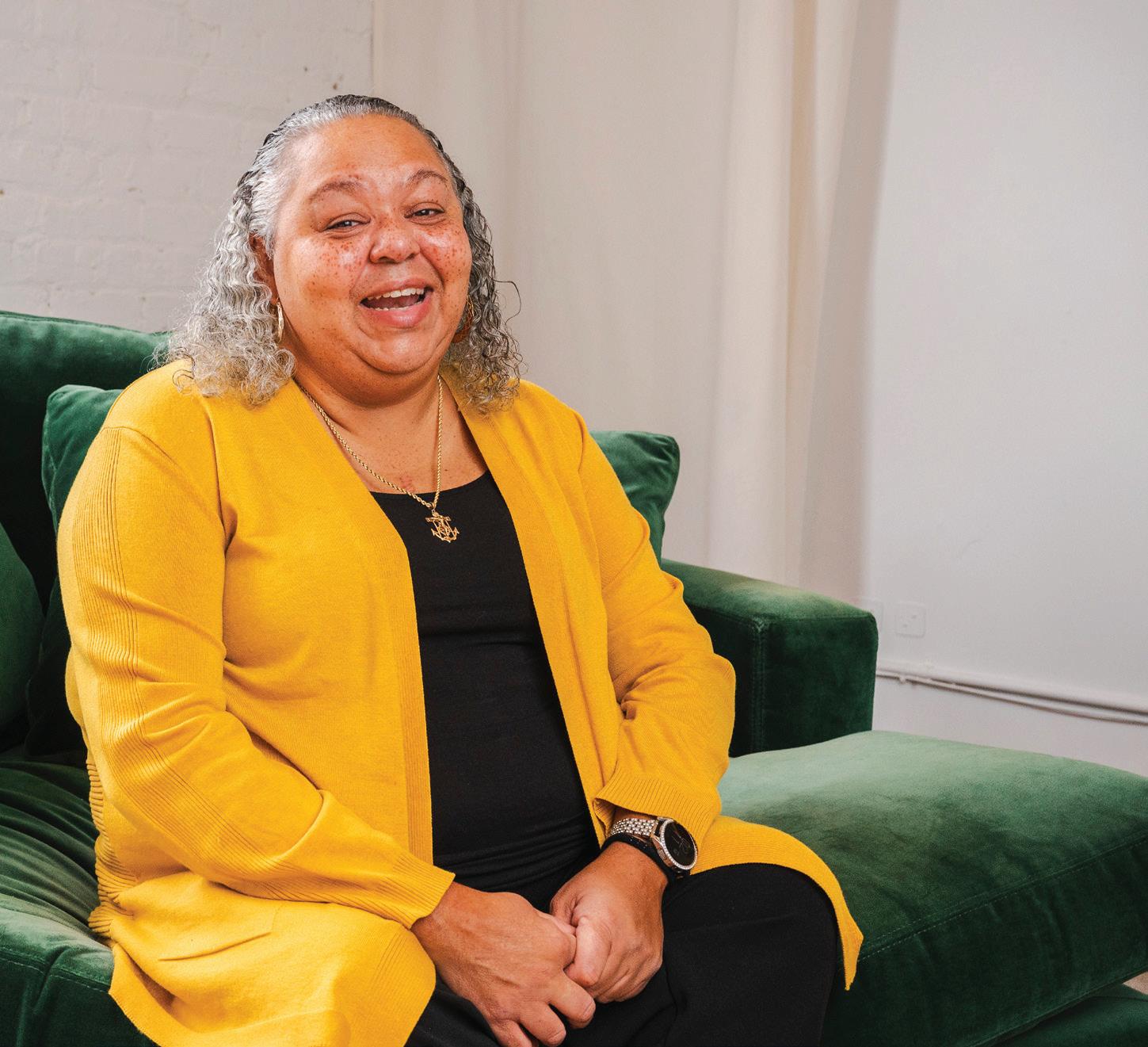



By Jasmine McBride Associate Editor
For Cornel Beard, creativity has always been a calling. From sketching T-shirt ideas in high school to leading branding campaigns for cultural institutions, the founder of Charizma Agency has carved out a space where design becomes a vehicle for impact, identity, and legacy.
Beard’s path to entrepreneurship wasn’t linear. After struggling academically in high school, he joined the U.S. Army, where he served for six years. “I didn’t stop drawing, though,” he said. “I ended up designing tattoos and shirts for people I was stationed
with. That creative drive never really left.”
After completing his service, Beard enrolled at Concordia University to study graphic design and later earned his graduate degree from the Minneapolis College of Art and Design (MCAD). As he transitioned from agency jobs to freelance work, he began envisioning something bigger: a team of culturally rooted creatives committed to advancing stories that matter.
In December 2022, Charizma Agency officially launched.
Two and a half years in, the firm works across brand identity, web design, campaign development, and creative strategy — serving clients like
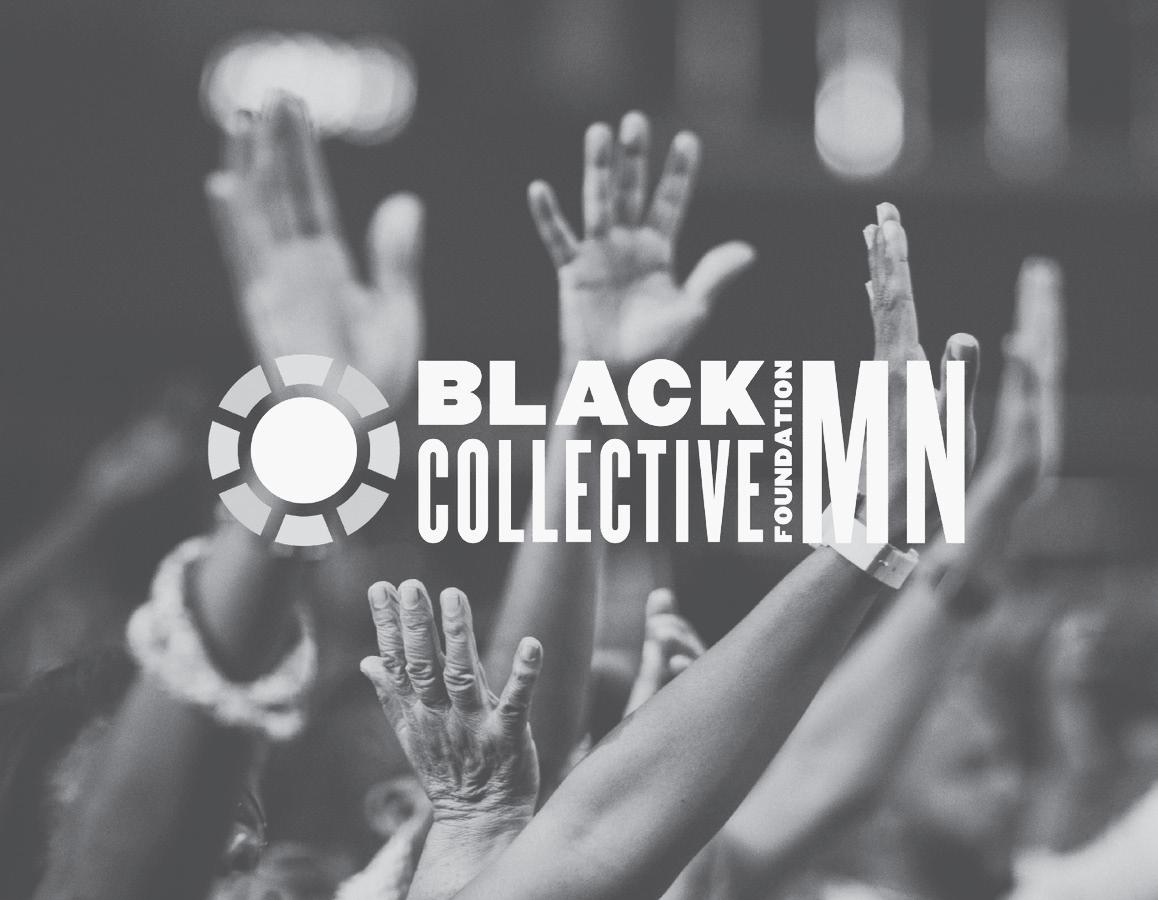
the Black Collective Foundation MN, 3Sixty Sports, and Carbon Sound through NPR.
“We believe anything that can be designed, should be designed,” Beard said. “But the goal isn’t just visual excellence, it’s pushing culture forward.”
“The goal isn’t just visual excellence, it’s pushing culture forward.”
Charizma is currently made up of a contractor-based team of three to five people, with two new hires slated to begin in August. The agency has found its niche helping organizations and movements tell stories rooted in community and authenticity.
“Working with Black Collective Foundation MN has been one of the most consis
tent and rewarding partnerships,” he said. “Whether it’s Juneteenth campaigns or upcoming conferences, the goal is always the same — design that moves people.”
The name “Charizma” is as intentional as the work behind it. “It’s rooted in sound and science; those memorable letters like K and Z that stick with you,” Beard explained. “But it also reflects how I led as a young soldier: not by yelling, but by being someone people



wanted to follow. That’s what charisma means to me — authentic leadership.”
As a father, Beard says legacy is never far from his mind. “I think about the work I’m doing today and how it shows up for my son tomorrow. Whether I’m up at 2 a.m. or wrestling with hiring decisions, that vision of legacy keeps me going.”
In today’s design world, Beard sees a growing trend he loves: storytelling through video, animation, and usergenerated content. “People are realizing their stories matter, and with technology, it’s easier than ever to share them. I encourage clients to lean into that — real stories, real voices.”
You can learn more about Beard’s work at www.charizma. agency, or follow the agency on Instagram at @charizma.agency.
While being a Black business owner in 2025 is “crazy at times,” Beard wouldn’t trade it. “There’s a lot happening in the world. But to wake up every day and build something from an idea, and then help others do the same — that’s a blessing.”



convicted by a jury who heard all the evidence,” he said, noting that the DOJ under the Biden administration retried Hankison after a mistrial in 2023. “The judge talked about how she was troubled. She agreed … that it seemed to be a 180-degree, about-face in the courtroom.”
Tamika Palmer, Taylor’s mother, told reporters that Jennings “did the best she could with what she had to work with … there was no prosecution [in the courtroom]
for us. There was no prosecution in there for Breonna.” She was unsure, however, if there was justice for her daughter: “We got something. I don’t think it was a fair sentencing, but it was a start.”
Death at the hands of police
The Monday afternoon hearing likely marks the end of a case that rocked the city, triggered outrage in the Black community, and led to weeks of protesters taking to the streets nationwide, demanding justice for a woman most had never met.
A 26-year-old emergency medical technician, Taylor was among a spate of unarmed Black people who died
at the hands of police in 2020, drawing attention to the issue of unjust, racist deadly force in America. Her killing came just months before a Minneapolis police officer killed George Floyd by kneeling on his neck on a downtown street corner.
The incident in Louisville unfolded early on March 12, when officers investigating a suspected drug ring obtained a “no-knock” search warrant to raid his home. Acting on bad information, however, the officers erroneously targeted Taylor’s home, barging in as she slept with her boyfriend, Kenneth Walker III.
Alarmed at the commotion, Walker grabbed his gun
and opened fire at the intruders, wounding one officer in the thigh. Stunned police returned fire, killing Taylor.
Though Hankinson didn’t hit Taylor — he was outside, and, without looking, fired 10 shots into the apartment through a window during the chaos — none of the other officers who actually shot her faced criminal charges. State prosecutors concluded the officers were justified because they were defending themselves against Taylor, but the police department sacked them.
Several others involved in the raid were disciplined or lost their jobs for providing faulty information about the raid and attempting to cover it up.

“He did not kill or wound Breonna Taylor”
In their sentencing memo, federal prosecutors wrote that, even though Hankison’s actions the night of the raid were “unreasonable given the benefit of hindsight,” he “did not kill or wound Breonna Taylor, her boyfriend, her neighbors, the defendant’s fellow officers, or anyone else.”
The government’s request for leniency, experts say, intentionally sends the message that the Justice Department — which, under former President Joe Biden, had reached an agreement to help reform the Louisville Police Department — now will likely abandon that deal. The retrenchment is in
line with Trump’s “anti-woke” agenda, and signals that prosecutors will no longer challenge race-based discrimination.
During the hearing, attorneys for Hankison and federal prosecutors seemed almost in sync in defending Hankison and recommending no prison time. At times, Taylor’s loved ones expressed frustration with prosecutor Rob Keenan — particularly when he agreed with Hankison’s defense team that their client wasn’t a threat to the public and should not receive a lengthy sentence.
This piece was originally published in Word in Black. For more information, visit www. wordinblack.com
barriers, but events like Black Business Week are part of a broader movement to close those gaps.
Building Black legacy
Before the construction of Interstate 35W in the 1960s, 38th Street was a thriving hub of Black culture and commerce.
Like St. Paul’s Rondo neighborhood, the area was gutted by highway expansion, redlining, and systemic disinvestment. The murder of George Floyd brought global attention back to the intersection, but it also catalyzed a new wave of purpose and pride.
At Thursday’s panel on Black legacy and entrepreneurship, six local business leaders shared their visions for wealth-building in the community: Chef Lachelle Cunningham (City Food Studio), C. Terrence Anderson (Bichota Coffee), P.J. Hill (PGMA Development), Tracey Williams-Dillard (Minnesota Spokesman-Recorder), Renay
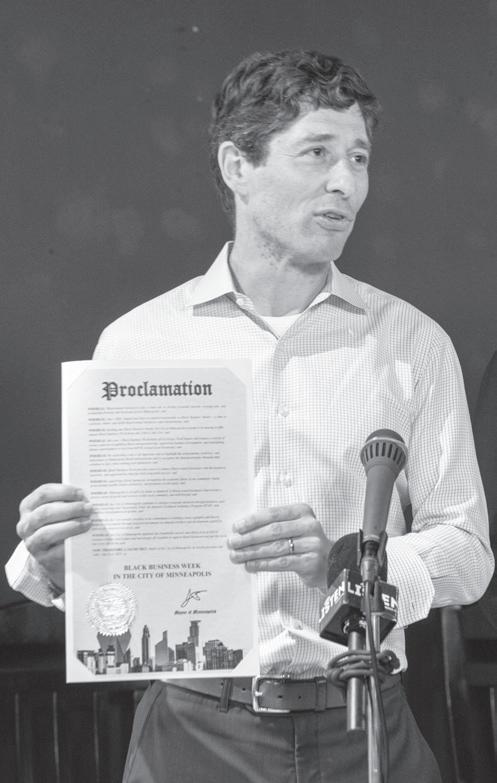
Hill said. “It’s how we move from survival to strategy.”
Tracey Williams-Dillard, publisher and CEO of the Minnesota Spokesman-Recorder, emphasized the importance of generational knowledge. Her family’s paper, headquartered on 38th Street for over 90 years, remains a rare example of sustained Black-owned media.
“I started my career at the age of eight because my grandmother brought me along and taught me,” said Williams-Dillard. “Legacy means giving our children the chance to learn by doing.”
Asa “Ace” Rice, founder of Plot Gallery, draws inspiration
from his family’s home of 76 years. “My goal is to see if we can get to 100 years in one house,” said Rice. “In business, we want Black artists to own their work. Too often we’re the face of a brand, but not the owners. That has to change.”
More than a week Minneapolis Mayor Jacob Frey opened the event by calling Black-owned businesses “foundational to the success of Minneapolis — past, present, and future.”
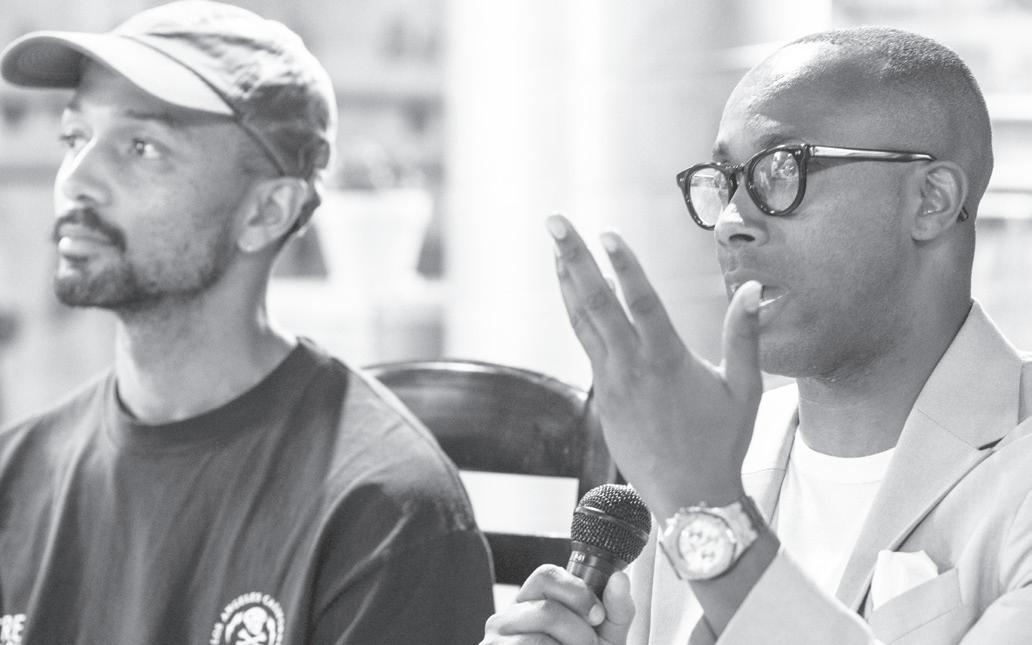
Dossman (Neighborhood Development Center), and Asa “Ace” Rice (Plot Gallery).
P.J. Hill, a former profes sional basketball player turned investment banker, launched his development firm in 2020. His goal: “Make 1,000 Black people multimillionaires.” His inspiration stems from his great-uncle, Pastor Curtis Farrar, who has owned the building at 3808 Chicago Ave for over 50 years. “Ownership is the gateway,”
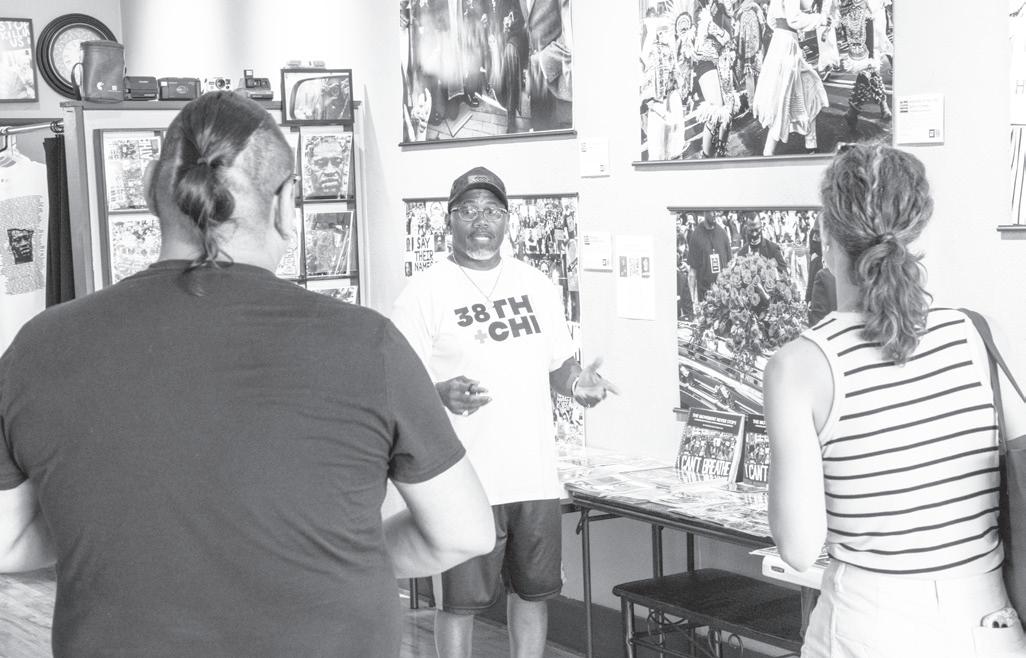
While the weeklong spotlight runs through July 31, business owners emphasized they are open, invested, and welcoming all year round. “We’re rejecting the narrative that this community is unworthy or not ready to be enjoyed and invested in,” Anderson said. “Vibrancy is allowed to look different than what we see in the ‘successful’ parts of the city. 38th and
“Vibrancy is allowed to look different than what we see in the ‘successful’ parts of the city. 38th and Chicago is full of brilliance already.”
Chicago is full of brilliance already.”
With each grand opening, mentorship session, and dollar reinvested into the block, a new legacy is taking shape, rooted in history, but reaching for the future.
Learn more about Minneapolis Black Business Week and local entrepreneurs at minneapolismn.gov.
Riley Bruce is a South Minneapolis-based photographer and videographer who contributes to the Minnesota Spokesman-Recorder.
to be removed from training, and frankly, he needs to be fired,” she said.
In a statement after the press conference, MPD Chief Brian O’Hara said Hanneman’s training tenure is currently set through August. “What he does next will be based on the needs of the department and our continued goal to build community trust,” O’Hara wrote.
Activists say the appointment does the opposite.
The Minneapolis Police Department is currently operating under a consent decree with the Minnesota Department of Human Rights after a 2023 investigation found a “pattern or practice” of racial discrimination. In that context, critics say Hanneman’s elevation to a leadership role erodes public trust.
Continued from page 10
in space. “I’ve had great teammates,” he said. “And I try to make that very clear when I speak publicly.”
He also emphasizes three traits that he believes matter, on Earth or in orbit: “Be resilient. That means growing through challenges.
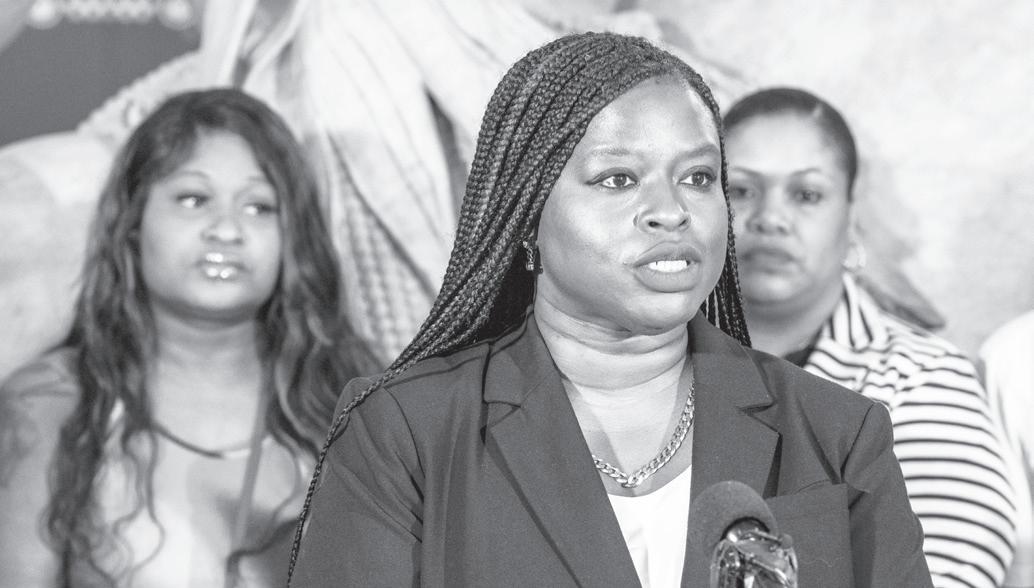
Frey’s office noted that the department’s use-of-force policies are subject to oversight by a court-appointed independent monitor: “No one has to take our word that we are committed to reform on faith alone.”
Political implications
With the 2025 mayoral race underway, activists like Marcia Howard, a community organizer and labor leader, view the mayor’s inaction as politically motivated.
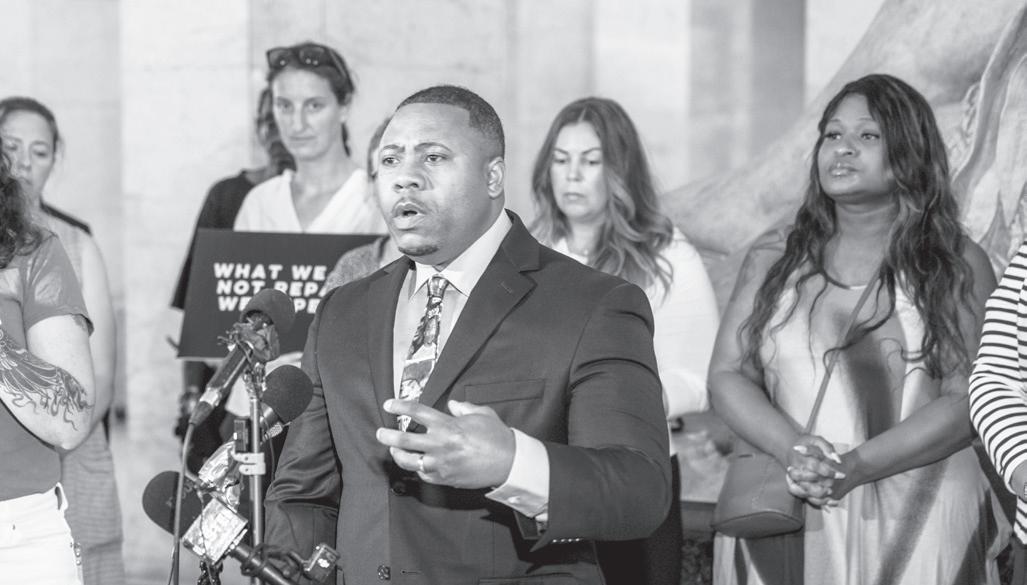
Spotlight on Mayor Frey
Much of the frustration was also directed at Mayor Jacob Frey, who holds sole authority over the police department under the city’s “strong mayor” system approved by voters in 2021. Though Hanneman was appointed by then-Interim Chief Amelia Huffman in 2021, activists say the mayor bears ultimate responsibility.
“From the very beginning, Mayor Frey responded to the killing of Amir Locke with chilling casualness,” said Kristen
It’s one thing to survive; it’s another thing to thrive, and sometimes the difference is mindset,” he explained.
“Be a lifelong learner. And be a good teammate. That’s something we all can choose. These three things help you not just succeed but define what success looks like for yourself.”
Even today, Glover still identifies as an athlete.
“I’m about to be 50, so I
Ingle, co-founder of SouthWest Alliance for Equity. She cited Frey’s 2022 comments, in which he said the city’s noknock policy lacked “necessary precision or nuance.” That policy, touted as a ban during his re-election campaign, was in place when Locke was killed.
“You cannot kick the can down the road and blame the City Council or anyone else,” Levy Armstrong said. “You alone are responsible for these decisions.”
In an emailed statement,

“If I were an elected official watching the wind blow, I’d elevate a killer cop to train other cops,” said Howard. “This is not about safety. This is a political pivot.”
As Minneapolis continues to reckon with its policing systems, community members say Hanneman’s appointment is a step backward — both for justice and for trust.
Editor’s Note: Nearly all of the recommendations from
the mayor’s Community Safety Work Group mentioned in this article have been marked as complete. A public dashboard tracking the status of those recommendations is available at: https://www.minneapolismn. gov/government/mayor/issuesand-priorities/community-safety/work-group/tracker
Riley Bruce is a South Minneapolis-based photographer and videographer who contributes to the Minnesota Spokesman-Recorder.
“What we do is incredibly dangerous, incredibly risky. But we’re also incredibly supported, prepared, and trained.”
can’t do what I used to,” he said with a smile, “but I still consider myself an athlete.”
When asked whether he’s ever afraid to go into space, Glover was candid.
“What we do is incredibly dangerous, incredibly risky. But we’re also incredibly supported, prepared, and trained,” he said. “That training helps bring the emotion down. The challenges are real, but we focus through them.”
Representation remains a top priority for Glover, who wants to see more Black
people, especially women, working in STEM and space exploration.
“We’re not quite there yet,” he admitted. “We need more women. We have better racial representation now, but the science and tech workforce in this country still doesn’t look like the country.”
Though Glover won’t be part of the NASA exhibition coming to the Minnesota State Fair from Aug. 21–24, he encourag-
es everyone to stop by and engage with the agency’s handson exhibits about the future of space exploration.
“NASA is an administration of our government,” Glover said. “We work for the people, and our mission is to explore the unknown in aerospace.”
Charles Hallman welcomes reader comments to challman@ spokesman-recorder.com.

By Vickie Evans Nash Contributing Writer
When Marvis Kilgore was praised for his work leading a Normandale College program to increase the number of Black male teachers in Minnesota, a colleague offered another suggestion: apply for a Bush Fellowship.
At the time, Kilgore was new to Minnesota from Mississippi and focused on establishing roots. He tucked the fellowship idea away for the future.
But when he eventually sat down to read the application, something clicked.
“I was like, ‘Oh my, this is going to be me,’” Kilgore recalled.
“I knew that I would be strategic — not just strategic to become a Bush Fellow, but strategic in the way I present my mission. Very focused on the results that I am getting for the community.”
Now a 2025 Bush Fellow, Kilgore aims to deepen his understanding of the educational inequities that leave Black men vastly underrepresented in Minnesota classrooms.
“I want to know how to meet with the people to understand the why, so I can be better informed to be a better leader [with] equitable solutions,” he said.
He estimates that less than 1% of Minnesota teachers identify as Black men. To help change that, Kilgore is launching a series of quarterly roundtables beginning in the Twin
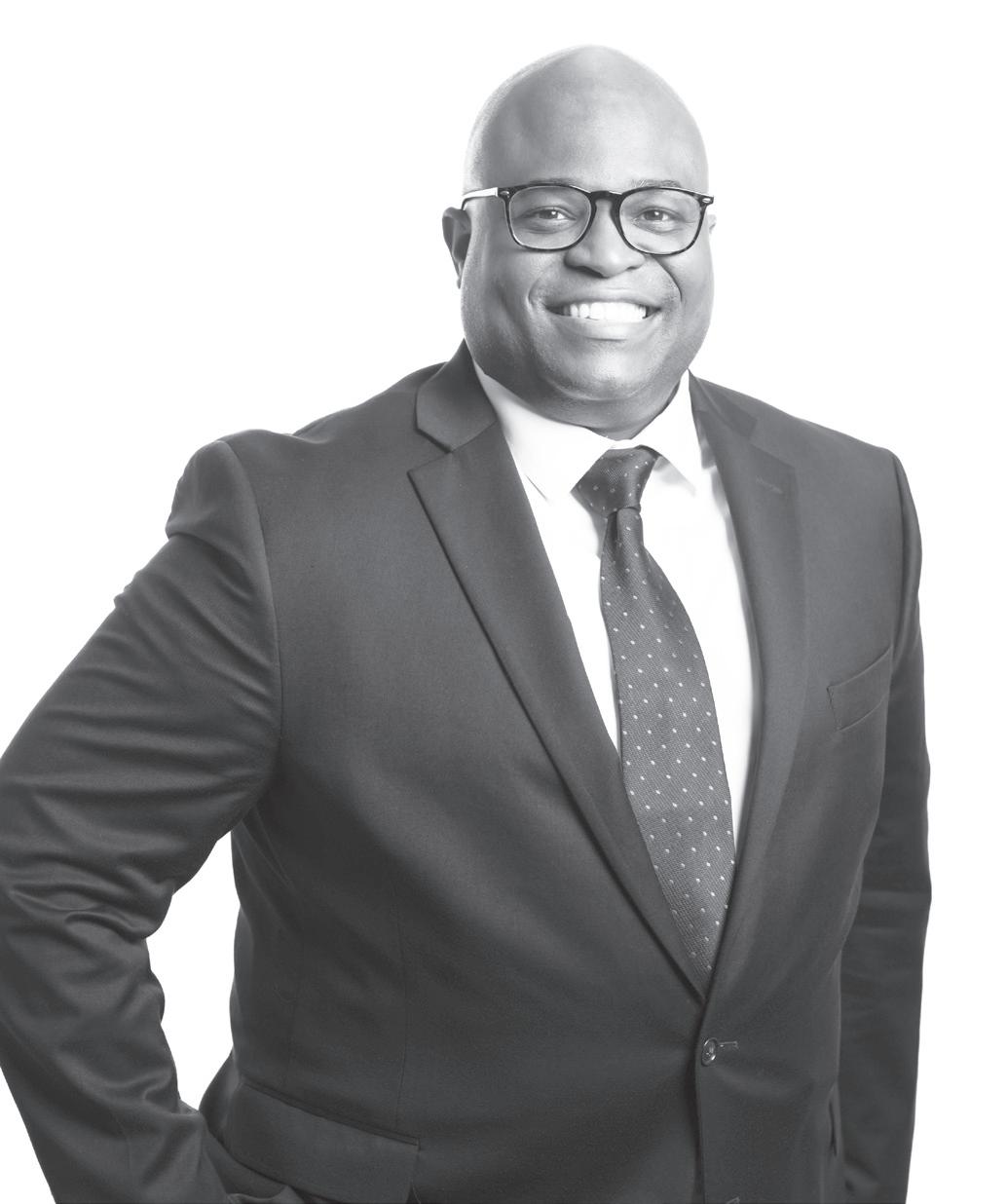
Cities and eventually expanding statewide. His goal is to bring community voices to the forefront of conversations on education; voices he says are missing from academic data.
“After studying all the peerreviewed research and reports, I kept thinking, where are the people? The numbers were extremely disconnected,” he said.
Kilgore’s Mississippi upbringing adds both clarity and complexity to his perspective. Growing up, he was surrounded by what he describes as a deeply rooted sense of community.
“I had people to see me, to

speak life into me,” he said. “It was just random people I would meet in the grocery store — that sense of community.”
In contrast, he finds Minnesota’s communities more “siloed and pocketed,” limiting the flow of ideas and support. That isolation, he believes, contributes to the underrepresentation of Black men in education and other fields.
“If we had a stronger sense of community, not just siloed neighborhoods, we’d have more Black male teachers in the classroom,” he said. “We’d have more students in STEM, particularly with coding. But



we have to make connections with the people.”
Kilgore is already building those connections through his work as executive director of Code Savvy, a nonprofit dedicated to equipping youth and educators with skills in technology. This summer, the organization is offering coding and STEM programming at Dayton’s Bluff Library in East St. Paul, led by community mentors.
terest in STEM, especially for underserved and underrepresented communities.”
To expand Code Savvy’s reach, Kilgore invites the community to get involved.
“I would just encourage community members, donors, potential mentors, and volunteers to reach out to us. Visit our website,” he said. “We have something for everyone. And to be most impactful, we need to partner with community in
vesting in yourself, fine-tuning your leadership, and becoming a better community servant.”
And if your application isn’t accepted the first time? Try again.
“Most fellows have applied more than once,” Kilgore said. “I would encourage people to quiet that inner saboteur. Make yourself enough by doing things to improve, and always ask people around you who aren’t afraid to tell the truth.
“Narrate from your perspective, from a position of strength, what you’ve done and why you’d make a good Bush Fellow.”
“The students are able to have meaningful interactions with mentors who look like them, whose lived experiences are like theirs,” said Kilgore. “They can ask questions, and hopefully that sparks an in-
the most authentic way.”
He also encourages others to consider applying for the Bush Fellowship.
“The Bush Fellowship is not about a project — you are the project,” he said. “It’s about in-
Marvis Kilgore is a 2025 Bush Fellow. For more information, visit www.bushfoundation. org/2025-bush-fellows/, and learn more about Code Savvy at www.codesavvy.org.
Vickie Evans-Nash is a contributing writer for the Minnesota Spokesman-Recorder. Vickie welcomes reader responses at vnash@spokesman-recorder.com.





By Robin James
The late, great Thelonious Monk once said, “Jazz is my adventure.” After all these years, I have to agree — my jazz journey, like Monk’s, has truly been an adventure of discovery, joy, and reflection.
Lately, I continue to be inspired by new talent and thrilled to hear fresh releases from seasoned jazz veterans.
Whether it’s celebrating a birthday, honoring an influence, or welcoming artists to the Twin Cities, there’s always something exciting to share.
One new artist who recently caught my attention is pianist, composer, and bandleader Paul Cornish.
The 28-year-old Los Angeles-based musician is signed to Blue Note Records and will release his debut album, “You’re Exaggerating,” this August.
The album features nine original compositions and includes notable collaborators: bassist Josh Crumbly and drummer Jonathan Pinson.
Of particular note is the track “Queen Geri,” a heartfelt tribute to one of Cornish’s influences, the late pianist and composer Geri Allen.
Cornish is part of a long lineage of talent on the Blue
Note roster — a lineage that includes the brilliant Sonny Clark, born July 21, 1931. A quintessential hard bop pianist, Clark is perhaps best known for his 1958 Blue Note release “Sonny’s Crib.” But for me, his playing on Lee Morgan’s “Candy” — especially the track “All the Way” — is absolutely unforgettable. Clark’s lyrical touch and rhythmic finesse on that piece never fail to move me.
Tragically, he died far too young at the age of 31, but his legacy lives on. Influenced by both Monk and Bud Powell, Clark’s sound continues to echo in the work of young artists like Cornish today.
“I
that Paul Cornish is helping carry the Blue Note legacy forward with staying power and creativity.”
I don’t think it’s an exaggeration to say that Paul Cornish is helping carry the Blue Note legacy forward with staying power and creativity. I wish him well as he embarks
on his own adventure.
Another new release that deserves your attention is “Out Late,” the May 16 release from pianist Eric Scott Reed on Smoke Sessions Records. It’s an album worth celebrating, not only for its musicianship, but for the powerful personal statement Reed makes through the music.
“Out Late” features a stellar quintet: trumpeter Nicholas Payton, tenor saxophonist Eric Alexander, bassist Peter Washington, and drummer Joe Farnsworth. These respected jazz veterans contribute both fire and soul to the session.
The seven-track album includes:
• Glow
• All’umfr’s
• Shadoboxing
• They
• Out Late
• The Weirdos
• Delightful Daddy
“Every city has its own late-night vibration,” says Reed. “No shade to Paris or Vegas or Philly or Los Angeles, but being in New York City is not like being anywhere else in the world. “Out Late” references the nightlife — the energy, the activity, the pulse.”
He adds, “It’s also about finding myself much later in
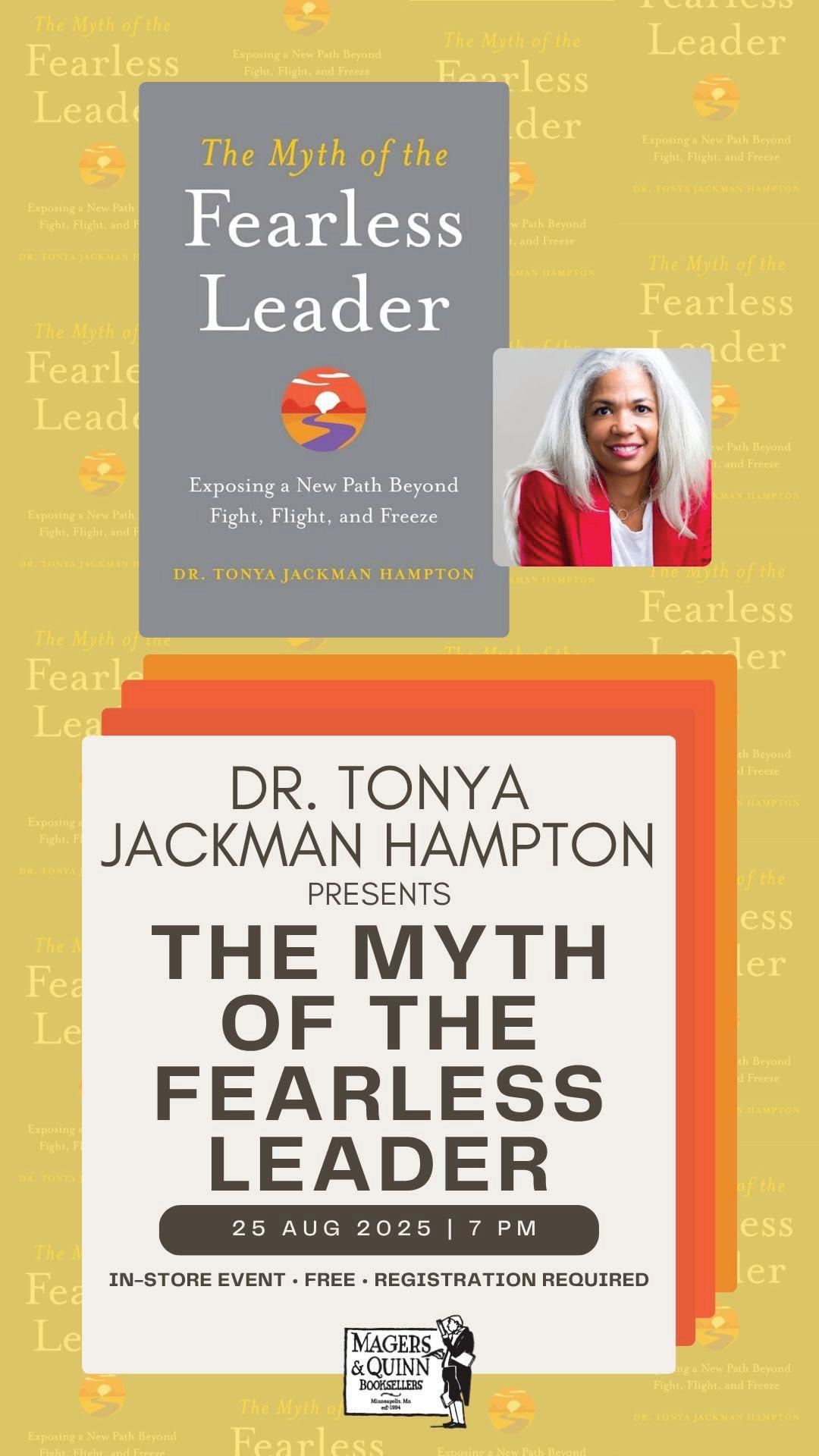



life. It’s about finally being able to embrace myself — my whole totality, my whole personage, who I am, who I love, why I do what I do, and how it all intertwines.”
Each track on “Out Late” was recorded in one take, in one room, the old-school way: no headphones, no overdubs — just raw, real chemistry. The result is jazz at its most honest and intimate.
And if you’re looking for live music close to home, mark your calendars for these upcoming shows at The Dakota in Minneapolis:
• Jane Monheit performs on August 16 at 7 p.m. The acclaimed vocalist is sure to treat audiences to selections from the Great American Songbook and her extensive solo discography.
• The always-energetic Re-


birth Brass Band brings New Orleans heat back to the Dakota on August 21 at 7 p.m.
For tickets and more details, visit www.dakotacooks.com.
Until next time, keep listening, keep learning, and enjoy the journey.
Robin James welcomes reader responses at jamesonjazz@spokesman-recorder.com.










By Andrew Krosch
How hard would you think it is to put some plain white paper, standard 8.5 x 11 in a plastic bag? Brain surgery hard? Rocket science hard? Not all that hard if you put a little effort in?
We all learned about supply chains recently. Maybe that’s the problem.
And what’s the problem, again? Typing paper for all of the Minnesota DOC inmates who need it for often time sensitive legal work and educational projects -- academic and religious -- with deadlines. This has been going on since last year.
from any of the twelve bagging stations the foreman’s desk oversees. As is cheap labor capable, for the most part, of putting item A (such as paper) into plastic bag B (above). Same plastic bag used for packaging when ‘typing paper’ is ‘in stock’, i. e. someone performed above assembly process, usually done in the “warehouse” work area. While said paper comes in reams of 500 and is sold in quantities of 100 the math ain’t that hard, even for an inmate. We can count in hundreds.
packed in the aforementioned standard 12x18 bag.
So why is it that inmates across the MN-DOC have been without any means of getting typing paper, a necessity for those in the process of filing legal work, others pursuing educational goals such as academic and religious degrees.
Our receipts should say, “Sorry we can’t be bothered with the simple process of bagging up paper to sell to you.”
By Frances Murphy (Toni) Draper
Let’s call this what it is.
The sudden release of over 230,000 pages of FBI files on Dr. Martin Luther King Jr. — two years ahead of schedule — is not about transparency. It’s a calculated, racially motivated campaign to tarnish the legacy of one of America’s greatest moral leaders. Discredit the man. Discredit the movement. Then, discredit the holiday.
Once public trust frays, the question becomes: Why honor him at all?
This latest move unfolds amid a broader reactionary wave: voter suppression, book bans, attacks on civil rights — all aimed at rewriting history.
Dr. King, the moral backbone of nonviolent protest, is the latest target. First comes character assassination via selective FBI leaks, next comes “debate” over whether he deserves a day on the federal calendar.
Let’s talk timing — or rather, twisted purpose. Charlie Kirk, a far-right activist and founder of Turning Point USA, recently declared, “MLK was awful … not a good person.” His real issue? That King helped usher in the Civil Rights Act of 1964 — a law Kirk now calls “a huge mistake.” Other right-wing voices suggest replacing MLK Day with Juneteenth, calling him “heinous” and using long-
debunked allegations to justify erasing him from memory. These aren’t just fringe opinions — they’re test balloons. Once public trust frays, the question becomes: Why honor him at all?
The holiday is not a handout. It is a moral marker. We have a stark warning from Fort Gregg-Adams, recently renamed back to Fort Lee. The base, once named for a Confederate general, was renamed in 2023 to honor two distinguished Black military heroes: Lt. Gen. Arthur Gregg and Lt. Col. Charity Adams, commander of the 6888th Central Postal Battalion. Two years later, the base was renamed again — this time after Pvt. Fitz Lee, a Buffalo soldier. A symbolic walk-back dressed in careful language, but make no mistake: it was a retreat. A retreat from reckoning with history. A retreat from centering Black excellence. A retreat that reeks of political calculation.
Black and first female appointee to the post, Dr. Hayden is an esteemed champion of access, literacy, and the preservation of marginalized voices. Yet, in a sudden and unexplained move, her leadership was pushed aside under pressure from those who claimed her stewardship was “too political”—code, in many circles, for being too inclusive. Too committed to truth. Too willing to tell the full story.
If they can quietly sideline Dr. Carla Hayden…If they can erase Fort Gregg-Adams… If they can ban books by Black a uthors and call it curriculum reform…If they can target AP African American Studies and claim it lacks “educational value”… If they can question the legitimacy of the Civil Rights Act… If they can tell lies about Dr. King and expect no accountability… What makes us think they’ll stop short of dismantling MLK Day?
These attacks are not about the past.
Legally, repealing the holiday would require an act of Congress. It’s never been done before. But in an era when cultural memory is increasingly shaped by ideology and outrage, the unthinkable becomes possible.
The ‘typing paper’ in this instance is the plain white paper in reams of 500, the same paper used in the printers in the canteen processing and distribution center.
For many years the said reams can be found stacked next to the foreman’s floor desk -- not technically within arm’s reach, the stack is two to four steps away from where they spend the majority of their eight hour shift -as well as next to their main office next to the inmate and employee bathrooms. Said paper fits perfectly into the 12x18 bags that are available
“Why is it that inmates across the MN-DOC have been without any means of getting typing paper.”
So while once again our receipts might say “product is currently out of stock” I will continue to stand by the above facts, conclusions I submit are easily verifiable, especially since each week, when I and thousands of other inmates in the MN-DOC order canteen we get a receipt printed on plain white 8.5 X 11 paper, the smaller orders
Is this the system’s failure to sell me and anyone else in the entire MN-DOC a few sheets of paper because of a particular management acumen?
Or is it intentional?
It would surely cut back on anyone filing briefs and claims against the MN-DOC and company. Hmmm. Does it matter? The result is the same.
I’m lucky. I have no legal work that’s due in court. No briefs to file while my literal freedom is on the line. What do the rest of us do? More time I guess....
Andrew Krosch (#206912) is incarcerated at MCF-Oak Park Heights. He can be contacted via TextBehind or JPay.
The same playbook applies elsewhere. Take the recent removal of Dr. Carla Hayden as Librarian of Congress. The first
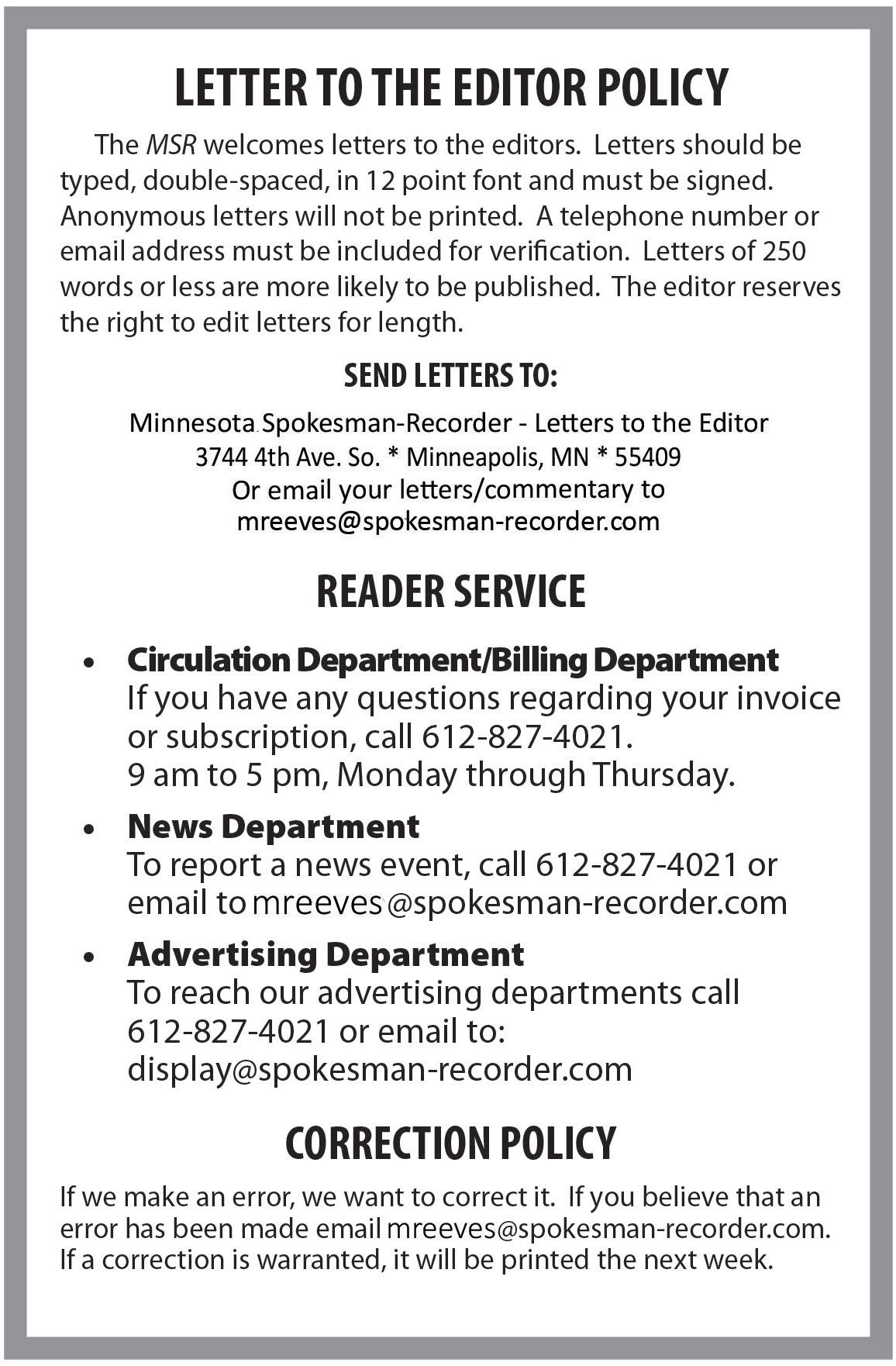
Let’s be clear: Dr. King didn’t march for a day off. He marched for justice — for a multiracial democracy that still struggles to be realized. The holiday is not a handout. It is a moral marker. That’s precisely why it’s in the crosshairs.
These attacks are not about the past. They’re about controlling the future. About silencing symbols that inspire progress. About rewriting American memory in ways that serve fear, not freedom.
The AFRO has always been on the frontlines of the fight for equality — speaking truth to power, exposing injustice, and amplifying Black voices. We’ve done it for more than 130 years, and we’re not stopping now.
We must heed the warning signs. Because if they can do all this in plain sight, imagine what they’ll try to do next.
Frances “Toni” Draper is the publisher of the AFRO-American Newspaper (the AFRO), with offices in Baltimore, Mary
land, and Washington, D.C.
By Tiffany Manuel
As the Trump administration wages war on our democratic institutions and social safety net, many of us who have fought for civil rights feel a life-or-death urgency to defend DEI and policies that advance health, racial equity, and democracy. And we know we must not give up on making the case for healing and repair.
But in a country where many people have long refused to talk about race, let alone our nation’s racist past and present policies, we’ve got to be strategic — especially in the face of an administration that lies, obfuscates, and erases the past.
If you’ve ever flown on an airplane, you know that takeoff is not instantaneous; the aircraft doesn’t just leap into the sky when the engines start. Instead, there is a process, a sequence of events that must unfold in order for a plane to achieve liftoff.
Helping people understand racial justice and the need for repair is like that, too.
I’ve studied decades of social science research and spent many years coaching leaders on how people think about race and what helps evolve their thinking. I’ve worked in communities where people are ready, even eager, to talk about the racist legacies of slavery and more recent policies like redlining — and to embrace solutions.
I’ve also been in places where I’ve said “equity” and community leaders have leaned over and whispered, “We can’t use that word here.”
You can’t use the same tactics in every place or with every group of people. But we have to keep talking about race and increasing people’s
understanding of what justice entails if we’re ever going to get to a future in which all Americans can thrive.
Don’t get stuck on labels
Imagine you’re teaching literature to students with vastly different reading levels. For the class to succeed, you must assess each student’s starting point and tailor your teaching accordingly.
The same is true for our conversations about race — whether at work, our kids’ soccer games, or school board and city council meetings. In some rooms, diving directly into a discussion about race will cause backlash. In others, failing to name it explicitly will lose the room.
people talk about injustice. Let’s say we’re talking about unequal access to resources or opportunities in education, housing, employment, transportation, or another aspect of life. We can point out that some may call that “unfair,” some may call it “discriminatory,” and some might say it’s straight-up “racist.”
We may not all agree on what to call it, but we can ask people to agree not to take it into our shared future. We can urge them to move beyond arguing about what to call injustice and instead do something about it.
Stages of takeoff
But how do we get people
“We all deserve a decent place to live and the ability to build a good life for ourselves and our families, no matter our job, race, age, or identity.”
Race-based discrimination in America is built on a history that is often untaught and misunderstood. Learning about race is much like learning a new language or playing a musical instrument: It takes time, practice, and patience. Despite the urgency we feel to make change now, we must create opportunities for others to learn and allow time for their understanding to develop.
We also have to avoid getting stuck on labels. The ways we describe racial inequities or responses to them — including “structural racism,” “DEI,” and other terms — can sometimes be barriers to effective conversations. Labels carry different cultural meanings across the country, making it challenging to find universally accepted terminology. A good tactic is to acknowledge the different ways
from one point on the spectrum of understanding to another?
I’ve seen firsthand that there are four stages to getting people to think differently about race, similar to an airplane’s progress down the runway.
First, we get people to “pull away from the gate.” We do this by simply naming race. By talking about how no matter where we come from — our background, race, or economic status — we all deserve to live in communities with great schools. We all deserve a decent place to live and the ability to build a good life for ourselves and our families, no matter our job, race, age, or identity.
This is a portion of “Give People What They Need to Fight for Racial Justice,” originally published in Word in Black. For more information, visit www.wordinblack.com.
ORDER
is in the Registrar’s possession, and that the will to which the requested appointment relates will be informally probated upon entry of this order.
7. That any notice as required by the laws of this State has been given.
8. That the application does not indicate the existence of a possible unrevoked testamentary instrument which may relate to property subject to the laws of this State, and which is not filed for probate in this Court.
9. That it appears from the application that the proceeding was commenced within the time limitation prescribed by the laws of this State.
10. That from the statements in the application, the person whose appointment is sought has priority entitling appointment, and is not disqualified to serve as a personal representative of the decedent.
11. That the application does not indicates that a personal representative has been appointed in this or another County of this State whose appointment has not been terminated.
12. That the decedent died on December 4, 2024 and at least 120 hours have elapsed since the decedent’s death.
13. That the heirs are as stated in the application.
14. That the application is approved in accordance with Rule 11.01 of the Minnesota Rules of Civil Procedure.
Now, therefore, it is ORDERED by the Registrar as follows:
1. That the application is granted.
2. That the decedent’s last will, duly executed on February 5, 1996 is informally probated.
3. That Matthew Dietrich Stoesz is informally appointed personal representative of the above estate, with no bond, in an unsupervised administration.
4. That upon qualification and acceptance, letters of administration issue accordingly.
Lindy Scanlon Registrar
Minnesota Spokesman-Recorder July 24, 31, 2025
NOTICE OF INFORMAL APPOINTMENT OF PERSONAL REPRESENTATIVE
Darlene Marie Gavin, FILE NO. 27-PA-PR-25-780

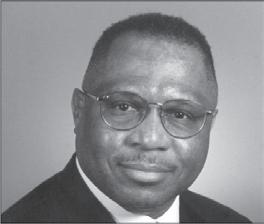

STATE OF MINNESOTA FOURTH JUDICIAL COUNTY OF HENNEPIN DISTRICT COURT PROBATE MENTAL HEALTH DIVISION
From Ads Department/MN
Spokesman-Recorder
In Re: Estate of
PHONE: 612-827-4021
FOR BILLING
Donna Jean MacDonald, FILE NO. 27-PA-PR-25-1036
INQUIRIES & TEARSHEETS
Deceased TO ALL INTERESTED PERSONS AND CREDITORS:
PLEASE CONTACT
ACCOUNTING DEPT
Notice is given, that an application for informal probate of the above-named decedent’s last will dated October 7, 2015, has been filed with the Registrar herein, and the application has been granted informally probating such will. Any objections may be filed in the above, and the same will be heard by the Court upon notice of hearing fixed for such purpose.
BILLING@SPOKESMAN-RECORDER.COM
PROBATE 2 WEEK RUN
FLAT RATE $215.00 PREPAID
Notice is hereby further given that informal appointment of Bruce M. MacDonald, whose address is 4340 11th Avenue South, Minneapolis, Minnesota 55407, as personal representative of the estate of the above-named decedent, has been made. Any heir, devisee or other interested person may be entitled to appointment as personal representative or may object to the appointment of the personal representative and the personal representative is empowered to fully administer the estate including, after 30 days from the date of issuance of letters, the power to sell, encumber, lease or distribute real estate, unless objections thereto are filed with the Court (pursuant to Section 524.3-607) and the Court otherwise orders.
Please Note: New email address for all future ads is ads@spokesman-recorder.com
The MSR handles billing digitally. This means you will get e-tears and e-mailed invoices unless you specifically request a hard copy.
Notice is further given that ALL CREDITORS having claims against said estate are required to present the same to said personal representative or to the Probate Court Administrator within four months after the date of this notice or said claims will be barred.
Dated: July 15, 2025
Yvette M. Andrade Registrar
STATE OF MINNESOTA FOURTH JUDICIAL
COUNTY OF HENNEPIN DISTRICT COURT PROBATE MENTAL HEALTH DIVISION
In Re: Estate of Ying Vang, FILE NO. 27-PA-PR-25-673 Decedent.
A Petition for Determination of Descent has been filed with this court on May 2, 2025. The petition states that the Decedent died more that three years ago leaving property in Minnesota. It requests that descent of such property to be determined and assigned by this court to the persons entitled to the property.
IT IS ORDERED AND NOTICE IS GIVEN that pursuant to Minnesota Supreme Court Order ADM20-8001 a hearing will be heard remotely on August 6, 2025 at 10:30 a.m. by this Court on the Petition for Determination of Descent.
From Ads Department/MN Spokesman-Recorder
If you wish to appear at the hearing, please contact the court by phone at (612) 3486000 so that arrangements can be made for you to appear.
PHONE: 612-827-4021
If you object to the relief sought, you must file a written objection with the court by 4:30 p.m. on August 5, 2025. Written objections not filed by the ordered date and time will not be considered. Written objections many be filed with the required filing fee on of two ways: 1) Mailed to Hennepin County District Court - Probate/Mental Health Division, 300 South Sixth Street - C4 Govt. Ctr., Minneapolis MN 55487-0340; or 2) Electronically filed using the electronic filing system.
FOR BILLING INQUIRIES & TEARSHEETS
PLEASE CONTACT ACCOUNTING DEPT
BILLING@SPOKESMAN-RECORDER.COM
PROBATE 2 WEEK RUN FLAT RATE $215.00 PREPAID
IT IS FURTHER ORDERED that notice shall be given by: 1) publication once a week for two consecutive weeks in a legal newspaper in Hennepin County, the last publication of which is to be at least ten (10) days before the deadline for objections; and 2) mailing via U.S. Postal Service a copy of this Notice and Order postmarked at least fourteen (14) days prior to the deadline for objections to all interested persons as defined in Minnesota Statues 524.1-401 and persons who have filed a demand for notice pursuant to Minnesota Statutes 524.3-204. Any charitable beneficiary may request notice of the probate proceeding be given to the attorney general pursuant to Minnesota Statutes 501B.41, subdivision 5.
Please Note: New email address for all future ads is ads@spokesman-recorder.com
The MSR handles billing digitally.
June30, 2025 BY THE COURT: Julia Dayton Klein Judge of District Court Minnesota Spokesman-Recorder July 31 & August 7, 2025
This means you will get e-tears and e-mailed invoices unless you specifically request a hard copy.
From Ads Department/MN Spokesman-Recorder
PHONE:
IT Company (Plymouth, MN) seeks Software Engineer to analyze, design & develop various software applications using advance technologies such as JavaScript, Angular JS jQuery, HTML5, CSS3, Bootstrap, SASS/SCSS, Jasmine, Node.JS, Webpack, RESTful, Github, Microsoft Visual Studio. Create test cases, perform various tests and troubleshooting. Generate customized reports. Offered Salary: $102,960.00 - $103,000.00/yr. Send resumes to: HRD, VITS Consulting Corp., 14264 23rd Ave N, Plymouth, MN 55447
PROBATE
Minnesota Spokesman-Recorder
Continued from page 10
really shows on the court. When you trust your teammates, you play with full effort.”
Burton said her goal is to
Continued from page 10
Phillips. “We were homeboys and homegirls.”
Smith’s Gopher career was disrupted by a 1986 sexual assault case involving him and two teammates. Though all were acquitted, the incident rocked the program. The university barred their return, prompting Coach Dutcher’s resignation and leading to Clem Haskins’ hiring.
remain steady under pressure. “Consistency is a big thing. The more consistent I can be as a point guard, it benefits everyone. That’s a goal for me, to continue to grow in my consistency.”
Charles Hallman welcomes reader comments to challman@ spokesman-recorder.com.
From Ads Department/MN Spokesman-Recorder
“Even though they were acquitted, they weren’t welcome back,” Wilson recalled. “Kevin was a really, really nice guy. We even drove back to Michigan together a couple of times. I was just looking at pictures the other day.”



Smith played in 47 games, scored 210 points, and pulled down 144 rebounds across two seasons
Charles Hallman welcomes reader comments to challman@ spokesman-recorder.com.
A personal note As someone who’s covered Gopher sports for over 40 years, I had the privilege of interviewing and reporting on both Jackson and Smith during their time at Minnesota and beyond. News of their passing has been hard to process. My thoughts and prayers are with their families, friends, and former teammates. May their legacies continue to inspire.



he Minnesota Lynx (22–4) extended their winning ways with a commanding 109–78 victory over the defending champion
Las Vegas Aces (12–13) on Friday, July 26, 2025, at Target Center.
WNBA MVP frontrunner Napheesa Collier led the Lynx with 25 points.
was one of five players in double figures,
added 10 off the bench. A’ja Wilson paced the Aces with 15 points, while Jackie Young added 14 in the loss.
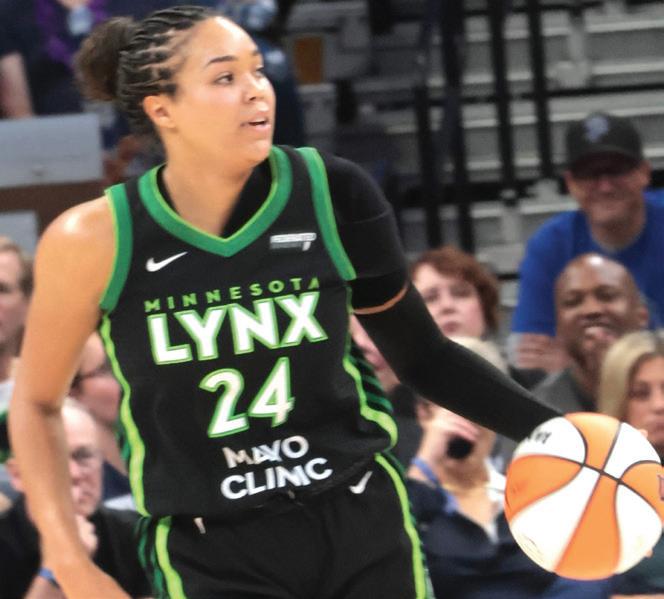

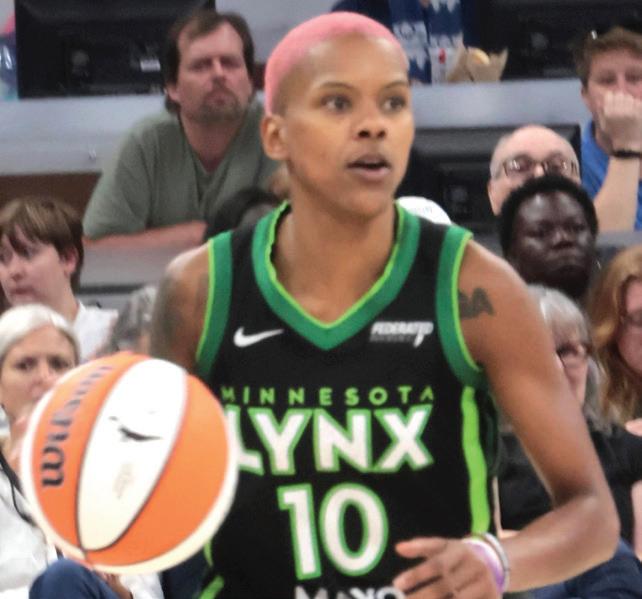
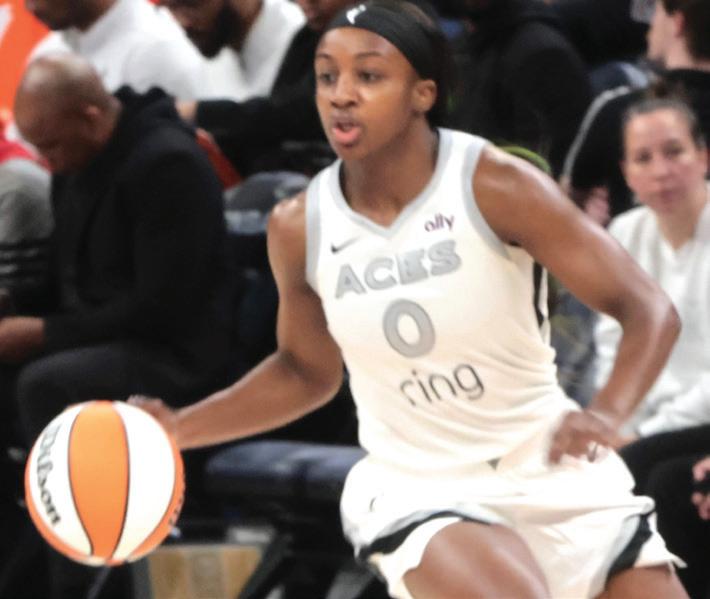
By Charles Hallman Sports columnist
ndianapolis, IN
he speaks to young people, NASA astronaut Victor Glover likes to keep his introductions short and simple. No long list of accolades. No ré-
“I do not like to be introduced by having my résumé read because to me, that builds a wall between me and those kids,” Glover told the Minnesota Spokesman Recorder (MSR). “So, I try to connect as a person; I’m a human being. I make mistakes.”
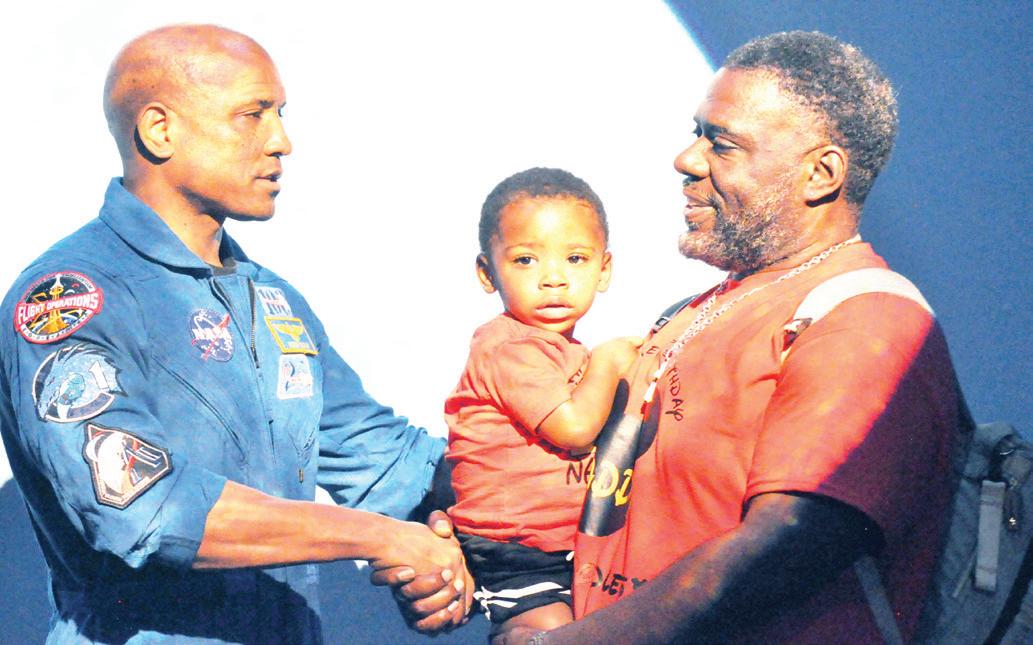
Glover visited the Children’s Museum of Indianapolis during WNBA All-Star Weekend earlier this month, where he hosted two meetand-greets as part of “Shoot for the Stars,” a STEM-focused program presented by
the WNBA.
He is one of four astronauts selected to fly on NASA’s historic Artemis II mission, scheduled for 2025, the first crewed trip around the Moon in over 50 years. Glover will serve as the pilot, making him the first Black astronaut assigned to a
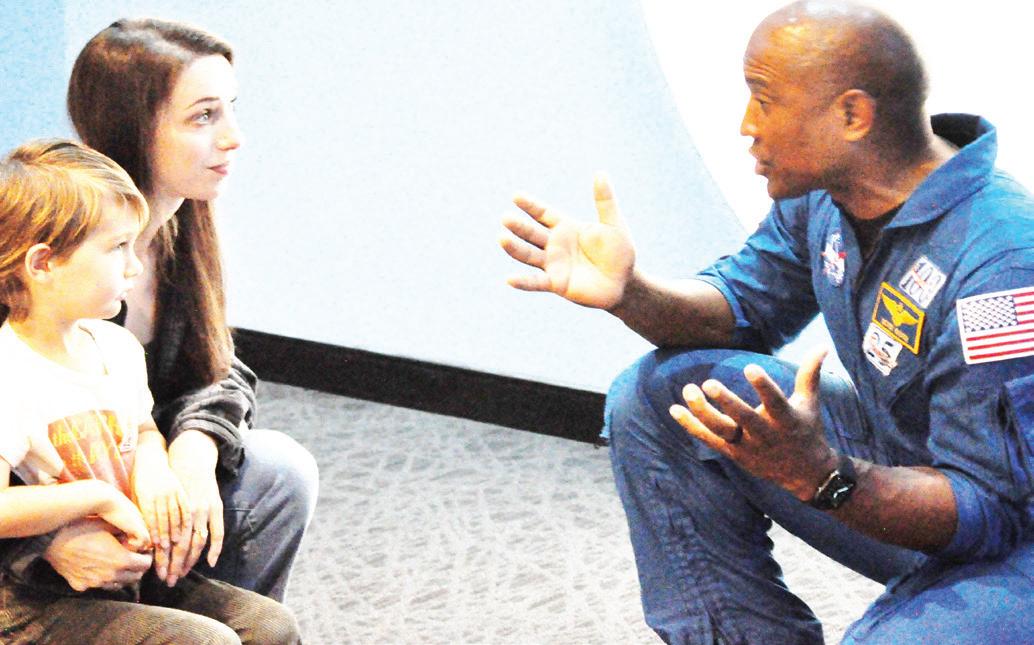
By Charles Hallman Sports Columnist
he Golden State
Valkyries are doing what few thought possible for a first-year WNBA expansion team: winning.
Rather than struggling through a traditional rebuild, the league’s 13th franchise is making history. Golden State has sold out every home game and currently leads the WNBA in attendance. With one of the top five defenses in the league, the Valkyries recently became just the third expansion team to reach 10 wins within 20 games — joining Minnesota (1999) and Detroit (1998). The team is on track to possibly become the first expansion club to make the playoffs in its inaugural season.
Much of that success comes from its balanced roster: three rookies and six veterans with at least three years of WNBA experience, five of whom have appeared in over 100 career games.
Golden State may be setting a new blueprint for future expansion teams.
“I think the main thing is just that we play for each other,” said forward Kayla Thornton, speaking to the MSR during All-Star Weekend. Thornton, a 10-year WNBA veteran, was the franchise’s first-ever AllStar selection. In her All-Star Game debut, she finished with 15 points, 11 rebounds, five assists, and two four-pointers — becoming just the fourth player in league history to record such stats in a single ASG.
Selected by Golden State
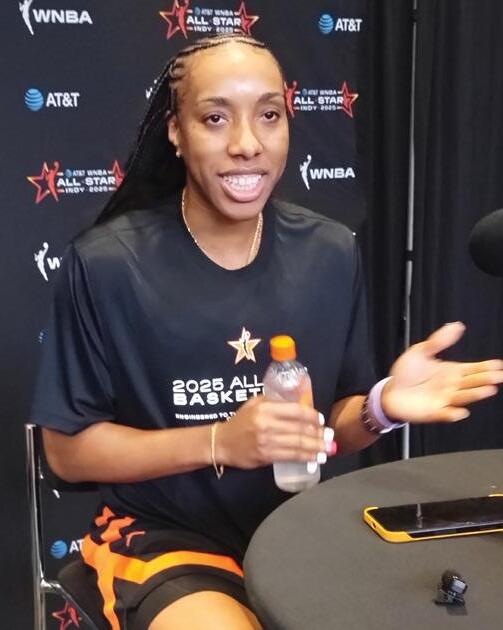
“I just kind of stay the course God has for me,” Thornton said. Unfortunately, her season came to an early end last week when she suffered a right knee injury during practice. The team announced she underwent successful surgery and will miss the rest of the season. She finishes the year averaging 14 points, 7.0 rebounds, and 1.5 assists in 22 games.
in the expansion draft from New York, Thornton joined the Valkyries after helping the Liberty capture the 2024 WNBA championship. She transitioned from a key reserve to a full-time starter and made an immediate impact.
Thornton and teammate Veronica Burton are among six Valkyries players to record double-doubles this season — more than any other WNBA team. Thornton notched her 15th double-double on July 5 against the Lynx (13 points, 10 rebounds) and was named Western Conference Player of the Week in Week 4.
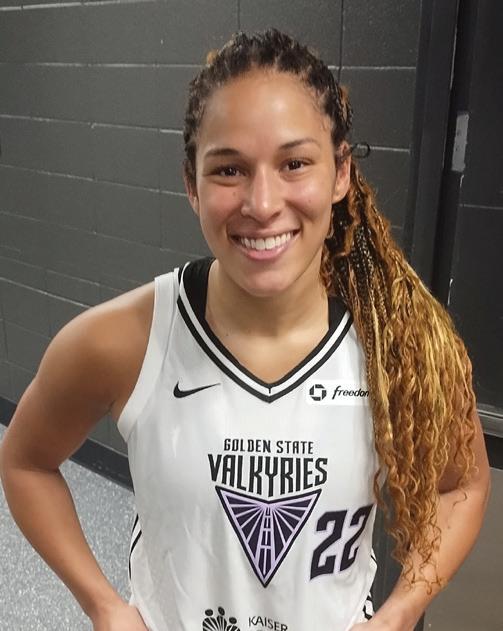
Burton, a 5-9 point guard selected from Dallas in the expansion draft, is also having a breakout year. She ranks fifth all-time in WNBA history in free throw percentage (.877) among players with at least 100 attempts and is the only player this season with multiple 10-assist, zero-turnover games — coming against Las Vegas and New York.
“We play together as a team, and that really shows on the court.”
“I’m grateful for my team here and my coaching staff,” said Burton, a fourth-year pro out of Northwestern. “They value each and every player. Whoever walks into our locker room is put in a position to succeed and use their skill set.”
Thornton praised Burton’s leadership: “She’s really flourishing in her role. Her point guard abilities to make plays for us… I’m just proud of her because she’s taking that leadership and building each and every day.”
“Basketball is a team sport, and the trust aspect is there,” added Burton. “We play together as a team, and that
lunar mission and one of only 18 Black Americans to travel to space since 1983.
While Artemis II will be groundbreaking, it’s not Glover’s first time beyond the Earth’s atmosphere. In 2020–21, he served as pilot on SpaceX’s first operational mission to the International Space Station (ISS), spending 168 days in space, conducting four spacewalks and helping complete a range of scientific experiments and maintenance work. A former Navy test pilot, he’s logged over 3,500 flight hours across 40 different aircraft.
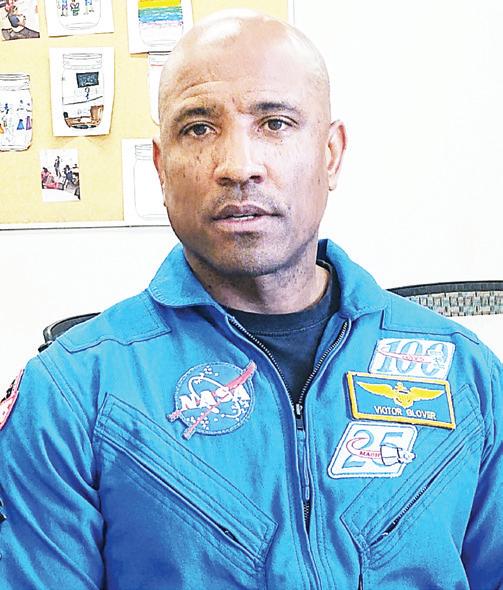
“I wanted to play in the NFL. I wanted to wrestle in the Olympics,” he shared. “But I wasn’t that good.”
Even so, Glover credits athletics for preparing him for life
■ See GLOVER on page 5
But long before the astronaut training and high-altitude missions, Glover was a college football player and wrestler who once dreamed of making the NFL or the Olympic team.

By Charles Hallman Sports Columnist
he Minnesota Gopher
athletics community is mourning the loss of two former standouts, Sue Jackson and Kevin Smith, who each left an indelible mark during their time in Dinkytown.
Sue Jackson (1972–2025)
Sue Jackson, Minnesota’s first Black volleyball superstar, passed away on June 18 in Kalamazoo, Michigan. Services were held June 26. A threesport standout at Comstock High School, Jackson led her volleyball team to three state championships before joining the Gophers from 1990–1993. She played in the pre-rally scoring era, when the team still held matches at Williams Arena, and quickly became a fan favorite.
Jackson, a dynamic setter, led the Gophers in assists each
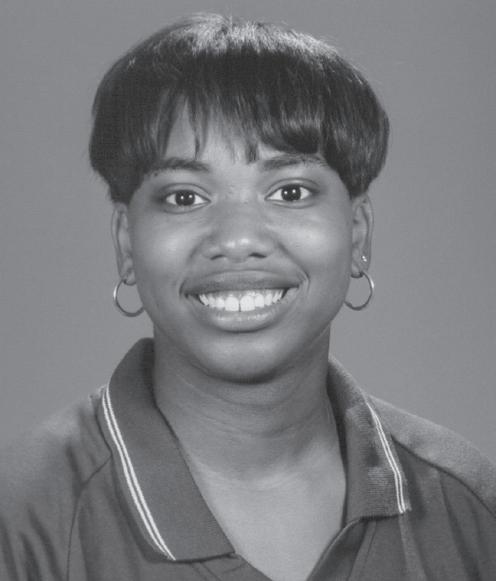
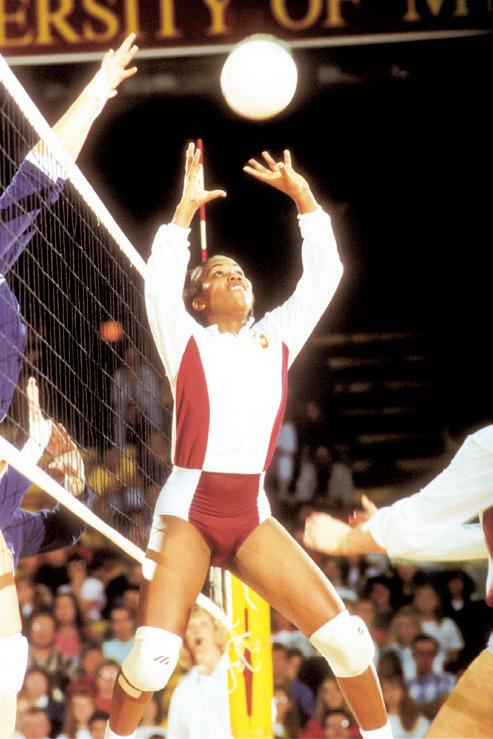
Wayne Walker in her hometown of Kalamazoo, becoming Susan Marie Jackson Walker.
Together they raised two sons. Jackson was inducted into the M Club Hall of Fame in 2001 and will posthumously enter the Comstock Hall of Fame this year. More than her accolades, she’ll be remembered as a mentor, teacher, mother, wife, and woman of faith.
“Susan was nothing short of a blessing to our teams, school and community,” said longtime Comstock coach Jeff Borr.
Kevin Smith (1964–2025)
season and finished her career ranked fifth in program history with 5,120 assists. She was a two-time All-Big Ten selection, a three-time captain, and the team MVP in 1993. Her final play in a Gopher uniform was the stuff of legend: diving head-first off the raised court at Williams Arena, trying to save a match point against Notre Dame. The crowd fell silent. Even Notre Dame players withheld celebration until Jackson stood up on her own. That was Sue, tenacious, fearless, and teamfirst.
After college, Jackson played professionally overseas and later coached at Minneapolis North and South high schools, Macalester College, and her alma maters Kalamazoo College and Comstock High. She earned her master’s from Concordia University–St. Paul and taught as an adjunct professor in special education. In 2007, she married Du-
Kevin Smith, a former Minnesota men’s basketball player and Lansing, Michigan native, passed away July 21. A forward on Jim Dutcher’s final Gopher squads in the mid1980s, Smith played in 47 games, scored 210 points, and pulled down 144 rebounds across two seasons.
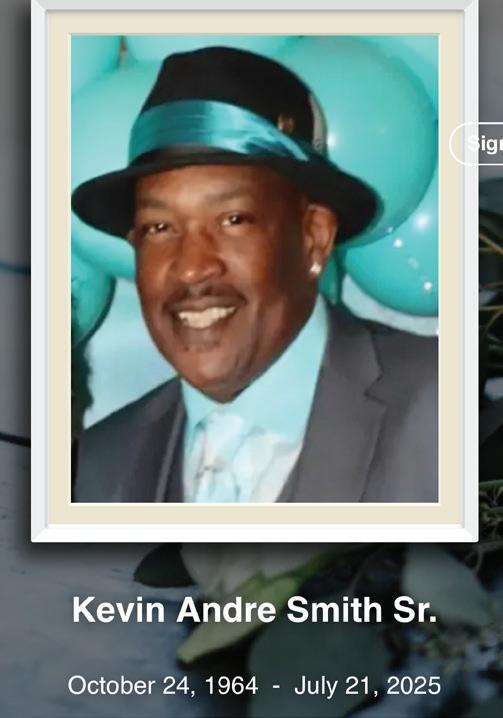
“He was All-American,” said Minneapolis NAACP President Cynthia Wilson, a fellow Lansing product who played at the same high school as
when she was known as Cindy